Joseph Paul Digital Agency is a team of experts SEO's, designers, and developers. We specialize in helping businesses rank high in local search engine results leading to more sales for your company. We are not a one-trick pony; we also optimize your...
Don't wanna be here? Send us removal request.
Text
Social Media Strategist Intern
Report to CEO
Design and Develop Your Strategy
Document Results To Share With Future Employers/Clients
Work Remotely
Highly Flexible Schedule
Social Media Intern Job Responsibilities:
Manages the company’s social media accounts and posts content.
Brainstorms campaign ideas and full strategy.
Monitor various social media platforms, such as Facebook, Instagram, and Linkedin.
Analyzes analytics to gauge the success of campaigns.
Understands the overall concept of the company, including the brand, customer, product goals, and all other aspects of service.
Engages with the CEO or project manager to execute Social Media Strategy
Provide suggestions to management for improving customer experience on social platforms and internal processes.
Learns and becomes proficient on internal software systems.
Assists in creating performance reports.
Work Hours & Benefits
If you’re looking to test (and prove) what you’ve learned in school, this is the internship for you. We are looking for a highly motivated Social Media Intern who can help grow our presence and document it for themselves with full transparency. You will be working closely with the CEO and project manager to support gaining agency experience.
You will also be able to share the strategy you developed, and its results with extreme transparency with potential employers or clients should you decide to become an Entrepreneur. The position is fully remote and you make your own schedule.
Social Media Intern Qualifications / Skills:
Social media marketing
Online engagement
Verbal communication
Organization
Professionalism
Customer focus
Education, Experience, and Licensing Requirements:
In 3rd or 4th year of college graduate program or beyond
If you’re ready to prove you have functional knowledge to develop a social media strategy and have data to support it, then this is the internship for you. Fill in the form below, and we’ll get in touch!
Benefits of Working at JPDA
Part of a culture that prides itself on being all about continuous improvement and developing oneself.
Flexible working hours, remote work and a great team!
Access to world-class SEO training and systems to follow for client delivery – learn real skills that you can build a career on.
Apply Here
Your name*
Email*
Phone
CV and/or Resume
Drop files here or
Briefly describe your job experience up until now*
It's ok if you don't have any but if you do, we'd love to hear about it.
Based on what you know, describe the job of a WordPress Developer*
Submit
jQuery(document).bind('gform_post_render', function(event, formId, currentPage){if(formId == 4) {jQuery('#input_4_3').mask('(999) 999-9999').bind('keypress', function(e){if(e.which == 13){jQuery(this).blur();} } );} } );jQuery(document).bind('gform_post_conditional_logic', function(event, formId, fields, isInit){} ); jQuery(document).ready(function(){jQuery(document).trigger('gform_post_render', [4, 1]) } );
The post Social Media Strategist Intern appeared first on Joseph Paul Digital Agency.
0 notes
Text
Remote Marketing and Operations Manager Application
Report to CEO
Continuous Learning
High Growth Potential
Anywhere in the World
1-2 Years of Experience
Applications close on November 10th
Now Hiring: Remote Marketing and Operations Manager
Joseph Paul Digital Agency (JPDA) is a US SEO Agency, helping companies to generate more leads and sales from Google and other major search engines. We are an Award-Winning US SEO agency helping companies get more business from Google & other major search engines.
Linkedin
About JPDA Marketing and Operations Manager
This is for a person who is super organized and willing to go the extra mile. As our Marketing and Operations Manager, you’ll be responsible for overseeing day to day administrative and operational functions of the business. You’ll report directly into our CEO. Your role will involve overseeing, managing and working on our client SEO campaigns, setting deadlines and liaise with freelancers and communicating with clients on campaign progress through calls, email, and reporting.
This is a full-time position.
What we’re looking for – Someone who loves working in a client-facing role and enjoys delivering real value. – Have experience in a key project management role and managing a team.
At least 1-3 years of SEO or digital marketing experience.
Self Starter, willingness to learn and can quickly learn to be a strong leader
Proficient Trello, Slack, Google Suite and similar tools.
Great at developing systems and infrastructure for growth.
Strong communicator – must be comfortable with taking client calls and liaising with JPDA team members. All in written and spoken English.
Super organized and precise with strong attention to detail.
Believe in consistently learning and bettering yourself.
Can come to the table with new ideas for improving campaigns, systems, and agency growth.
Confident speaking and writing in English Responsibilities
SEO Tasks
Keyword Research
On-page SEO
Technical SEO
Managing Link Building process
Managing our project management tool {Trello} – internally and client-facing
Briefing freelancers on campaign projects {via Slack mainly or email}
Liaising with our freelancers to make sure work is delivered on time and to a high standard
Regular communication with clients to keep them updated on campaign progress – emails, schedule calls, project management tools
Deliver best possible results to clients while still managing expectations
Answering client questions and queries promptly
Mapping out SEO activity for each client, each month and notify freelance team via Trello & Slack
Make sure monthly reports are delivered and sent to client.
Documenting all campaign processes using tools like process.st and Loom. Continue to update these as processes evolve.
Making sure our Google drive client folders are kept organized
Looking at ways to further improve our service delivery i.e better systems, new strategies & new team hires.
Working alongside CEO to come up with new offers that we can deliver for clients.
Able to make simple changes in WordPress (modify text and add/remove images)
Upload updates to Google My Business Profiles Must Have/Be
Available for weekly video conference calls with CEO – Speak and Write Fluent English
Friendly, patient and empathetic
A willingness to learn new things and educate yourself on SEO and digital marketing
Great message etiquette and communication skills
Available during weekly working hours (Eastern Time Zone) – 9-5 pm
Ability to deal with client and freelancers issues in an empathic and calm manner
Salary (after the trial period)
Provide your desired per month rate. Paid every two weeks via direct transfer.
Benefits of Working at JPDA
Part of a culture that prides itself on being all about continuous improvement and developing oneself.
Flexible working hours, remote work and a great team!
Access to world-class SEO training and systems to follow for client delivery – learn real skills that you can build a career on.
Apply Here
Your name*
Email*
Phone
CV
How much do you think a position like this should pay monthly?*
In a one minute video, tell us a little about yourself*
We want to hear you speak English. Send a Youtube link.
Any social media profile
Briefly describe your job experience up until now*
Tell us about some of the jobs you think may be relevant to this position. If this is were to be your first job, that's ok, tell us how you got here.
Based on what you know, describe the job of a Marketing Operations Manager*
Based on what you know, describe what SEO can do for a business*
Submit
jQuery(document).bind('gform_post_render', function(event, formId, currentPage){if(formId == 3) {gformInitCurrencyFormatFields('#input_3_11');if(typeof Placeholders != 'undefined'){ Placeholders.enable(); }jQuery('#input_3_3').mask('(999) 999-9999').bind('keypress', function(e){if(e.which == 13){jQuery(this).blur();} } );} } );jQuery(document).bind('gform_post_conditional_logic', function(event, formId, fields, isInit){} ); jQuery(document).ready(function(){jQuery(document).trigger('gform_post_render', [3, 1]) } );
The post Remote Marketing and Operations Manager Application appeared first on Joseph Paul Digital Agency.
0 notes
Text
WordPress Developer Intern
Report to CEO
Continuous Learning
Work Remotely
Highly Flexible Schedule
Now Hiring: WordPress Developer Intern
Joseph Paul Digital Agency (JPDA) is a US SEO Agency, helping companies to generate more leads and sales from Google and other major search engines. We are an Award-Winning US SEO agency helping companies get more business from Google & other major search engines.
Linkedin
About JPDA WordPress Developer Intern
We are looking to hire an intern WordPress Developer to take PSD/AI/XD field and convert them into WordPress templates using Divi theme our clients. You would be responsible for both back-end and front-end development including the implementation of WordPress themes and plugins as well as site integration and security updates.
To ensure success as a WordPress Developer, you should have a passion for applying creative solutions, a good eye for aesthetics, and strong content management skills. Ultimately, we want an intern who can make pixel-perfect websites but more importantly doesn’t get discouraged when things get challenging meeting client specifications.
WordPress Developer Responsibilities:
Meeting with clients to discuss website design and function.
Designing and building the website front-end.
Creating the website architecture.
Designing and managing the website back-end including database and server integration.
Generating WordPress Divi themes and plugins.
Conducting website performance tests.
Troubleshooting content issues.
Conducting WordPress training with the client.
Monitoring the performance of the live website.
WordPress Developer Requirements:
Studying Computer Science or a similar field.
Proven work experience as a WordPress Developer.
Knowledge of front-end technologies including CSS3, JavaScript, HTML5, and jQuery.
Experience working with debugging tools such as Chrome Inspector and Firebug.
Good understanding of website architecture and aesthetics.
Ability to project manage.
Good communication skills.
Positive attitude and eager to learn on the job!
Benefits of Working at JPDA
Part of a culture that prides itself on being all about continuous improvement and developing oneself.
Flexible working hours, remote work and a great team!
Access to world-class SEO training and systems to follow for client delivery – learn real skills that you can build a career on.
Apply Here
Your name*
Email*
Phone
CV
How much do you think a position like this should pay monthly?*
In a one minute video, tell us a little about yourself*
We want to hear you speak English. Send a Youtube link.
Any social media profile
Briefly describe your job experience up until now*
Tell us about some of the jobs you think may be relevant to this position. If this is were to be your first job, that's ok, tell us how you got here.
Based on what you know, describe the job of a Marketing Operations Manager*
Based on what you know, describe what SEO can do for a business*
Submit
jQuery(document).bind('gform_post_render', function(event, formId, currentPage){if(formId == 3) {gformInitCurrencyFormatFields('#input_3_11');if(typeof Placeholders != 'undefined'){ Placeholders.enable(); }jQuery('#input_3_3').mask('(999) 999-9999').bind('keypress', function(e){if(e.which == 13){jQuery(this).blur();} } );} } );jQuery(document).bind('gform_post_conditional_logic', function(event, formId, fields, isInit){} ); jQuery(document).ready(function(){jQuery(document).trigger('gform_post_render', [3, 1]) } );
The post WordPress Developer Intern appeared first on Joseph Paul Digital Agency.
0 notes
Text
20 SEO tools/services to make SEO in 2021 Easier
There are a million tools for SEO out there. You don’t have the time to find and then test them all.
The only reason why you’re thinking about SEO tools in the first place is to rank your website in minimal time.
Since I’ve been practicing SEO for 7 years, I’ve had the opportunity to test out many tools. Some were great, but others were terrible.
I thought to myself, “If I knew which tools are awful, why would we make you suffer through finding out yourself?” Today, I’m going to show you which SEO tools are worth the time (and money).
Below we’ve broken down some of our favorite tools and how to use them. Unlike most blog posts on the internet, we have no financial reward for suggesting any of the tools below, so I will be brutally honest.
SEO Tools
Ahrefs (Free or $99+)
Ahrefs is one of the industry standards when it comes to gathering SEO data on your competitors. Until recently, you could only get a 7-day $7 trial before committing to a bigger plan, but recently they began to offer a free plan.
They have a whole slew of tools built into their service, but they excel in one particular area.
With the most extensive backlink profile of 17 trillion known links, it’s arguably the most comprehensive backlink dataset outside of Google themselves. With this information, you can spy on your competition and see what type of websites and content is giving them the most backlinks.
Ubersuggest (Free or $29+)
I’ve talked about Ubersuggest before, and I still love the tool. It does a lot of similar to Ahrefs, but Neil did a fantastic job making the information you get more actionable.
The tool is continuously adding features, so our suggestion is to get the lifetime deal while still available to the public. Their data sets are only getting more extensive, and the Keyword Research tool is fantastic.
Search Console (Free)
If you’re not using Google search console, you’re not doing SEO; you’re hoping and praying. Google search console is an essential tool for anyone looking to improve their website traffic.
No tool in the world will give you more accurate data on what keywords your website is showing Google for and where. This data is coming straight from the horse’s mouth.
Relying on tools other than Google to get impressions, keyword, click-through rate, and ranking data is like playing a carnival game where they guess your weight. Sure the carnival employee is good at what they do, but the scale will be accurate 100% of the time.
Google Sheets (Free)
What does a spreadsheet software have to do with SEO, you ask. SEO is nothing but decision making based on data and a few set of rules. Google Sheets is perfect for organizing data, especially a large amount of data.
What few people don’t know is, it’s extremely good at pulling data also. One of my favorite features is pulling a website’s sitemap to see how big the website is and what its URL structure looks like.
To do this, type in the following formula:
=IMPORTXML(“INSERT_SITEMAP_URL_HERE”,”//*[local-name() =’url’]/*[local-name() =’loc’]”)
Hunter.io (Free or $49)
I could write a blog post titled “1 billion reasons why it sucks to do backlink outreach.” I’m not going to do that, but one big reason it sucks is finding emails to send your outreach email to.
You have to manually go to the website and check the privacy, contact page, or anywhere on their website to see if you can find an email.
Not anymore! Hunter has you covered like a raincoat. Hunter is a service that comes with an exention where with the click of a button or an upload of a spreadsheet, it will find any email related to the website you’re requesting.
It also has a feature that can automate personalizing and sending emails for you with follow-ups. Can you tell why I love this service yet?
The customer support is through the roof, and I’ve never seen a more dependable tool on the internet than this one.
Surfer ($49.20+/month)
Surfer is quickly becoming one of the most popular on-page SEO optimizers, and for good reason. Some would argue, “Yoast and RankMath both help you optimize pages and grade them.”
I agree to an extent with that statement. I would compare Yoast and RankMath to wearing a suit off the rack while Surfer is like wearing a custom-tailored suit. Both get the job done, but the ladder is going to fit you better.
Here’s why I made the analogy. Surfer analyzes 500+ ranking factors from your website and compares it to the top 50 web pages you’re competing against. With this data, you get an easy to read the report that includes target load speed, word count, target keywords, and much more within minutes.
CognitiveSEO ($129.99/month)
CognitiveSEO prides itself in its own words, “the only SEO tool you’ll ever need.” That’s a pretty bold claim. Once you get inside of it, you’ll begin to notice that it’s a massive tool, so let’s get into it.
Some services included with CongitiveSEO are backlink analysis, content optimizations, unnatural link detection, rank tracking, and an onsite website crawler.
Where they shine is how they present and report the data to you. It’s user-friendly and able to be printed to PDF; if you’re doing client work, this is very convenient.
Answer The Public ($99/month)
Want to be a mind reader? Now you can with Answer the Public! Answer The Public is an invaluable tool for my team and I to uncover industry questions that we can exploit with SEO quickly.
It’s pretty simple to use, really. Let’s say you’re doing mortgage broker SEO and stumped on topics to cover. You would type in “mortgage” into their search bar.
From there, Answer The Public will provide you with the most searched (auto completed) searches from Google. These are great long-tail keywords that will be much easier to compete for and attract much more focused traffic who’s more likely to contact you or buy.
Screaming frog ($194.14/year)
Screaming Frog’s SEO Spider is one of the world’s best website crawlers in the world. They get recommended by almost every SEO, and unless you have a huge website, you really don’t need the paid version.
The list of what they do is vast, and you should go to their web page to see all the exact features. I am going to cover some of my favorite use cases.
I like to use it to crawl a competitor’s website and see which pages are the most internally linked. This check will provide you with a good idea of what pages are most important to your competition.
I also like to use it to find which pages on my website load the slowest. The majority of the tools online only test one page at a time. With Screaming Frog’s tool, you can run one crawl and get results for every page.
Schema Markup Generator (Free)
If I asked you to make a JSON-LD schema markup, where would you start? Not sure? Me neither because I am an SEO and not a programmer.
That’s why I absolutely love this Schema Markup Generator by Merkle. They have an easy to use generators to create schema markups. Fill in a few fields, and now you’ve made a perfectly written JSON Schema Markup.
We use the local business one the most because it’s a strong confidence booster for Google that your information is accurate, making you more attractive to show as a result. Google even may make you a…
Google Rich Results Test (tool)
Since we’re on the topic of Schema, let’s talk Google Rich Results. Google Rich Results are those extra boxes you see in searches that answer your question directly in the search or provides more information.
The rich results test tool by Google will show you if you’ve implemented the JSON appropriately to be eligible for Google Rich Results. That’s great information to have, but I like to use good tools for evil sometimes.
A better use case for this tool is to take your competitor’s URL of a rich result, and run it through the tool. You can now see exactly which Schema markups they’re using and replicate on your site.
WordPress SEO Plugins
LinkWhisper ($77+/year)
LinkWhisper is a dream come true. Neil Patel has mentioned a few times in his videos on YouTube that he has full-time staff members internally linking his old content.
We all don’t have a staff of experts to help us do that. LinkWhisper allows the little guys like you and I to get the benefits from internally linking without having to staff a team of experts.
This WordPress plugin goes through all your content and uses magic (probably AI) to find relevant text to other topics you’ve covered. Is it as good as an expert, nope, but it gets the job done, and it will never ask for a holiday or vacation?
Rank Math (free)
Rank Math is a fantastic WordPress plugin for both novices and experts alike. Once you install the plugin, it will ask you how if you’re an expert or beginner.
Once you let Rank Math know your skill level, it will walk you through a setup process to help you set up your local SEO schema, sitemaps, meta branding, and much more.
Some bright spots for this plugin are its ability to select primary and secondary keywords for posts, select schema types for your posts/pages, redirection management, and easily choose what pages should be indexed.
These features come free with Rank Math, who doesn’t have a paid/premium version (yet).
YoastSEO (free or $89/website)
This is the original SEO plugin on WordPress. Since it’s been around for what seems like forever, it’s the most popular.
Yoast helps with your posts and pages by determining how optimized they are for your focus keywords and allows you to modify the meta-information easily.
If you have the budget for it, you can upgrade to the premium features that include redirection management, internal linking, Social previews, and much more.
Their bright spot is they explain standard SEO practices simply and concisely.
Ajax Search for WooCommerce ($49)
Although this Ajax’s plugin won’t help you rank better or even give you suggestions about improving your SEO, it will help you capitalize on the traffic you do get.
What Ajax does for your WooCommerce site is make your eComm store more accessible. Now your users can search for a key term and get the best products. To make purchasing products extremely easy, they even allow adding to cart straight from the search bar.
Chrome/Firefox SEO Extensions
Keywords everywhere ($10/100,000 credits)
Keywords Everywhere is a very convenient way to always to keep Keywords on your mind. What this extension does so well is provide you with search volumes on various websites that include Google, YouTube, Bing, and much more.
It also provides you with what the Cost Per Click (CPC) value of keywords you search. The information allows you to gauge the profitability and competition of any particular keyword.
It also shines by showing you what searches are related to the search you just performed. This allows you to adjust your SEO strategy by developing a content strategy rather than randomly posting.
Check My Links (free)
This Chrome/Firefox plugin allows you to check all the links on a webpage to see which are valid and which are broken.
Check My Links valuable to SEO’s because it can allow you to check a page for broken links and then reach out to the website owner to make them aware of it and suggest replacing the broken link with yours.
This is a broken link building strategy used by SEOs.
Strike Out No-Follow Links (free)
There are two types of backlinks, do-follow and no-follow (there’s actually more but not the time or place). Do-follow links from reputable websites have lots of value, and there’s no argument around that.
Where there are arguments is if no-follow backlinks add value and how much. This isn’t the place to argue it, but it is the place to show you how to spot them quickly using Strike Out No-Follow Links.
An over-simplified explanation of a no-follow link is when a website links to a website but adds additional code to the link to instruct Google not to follow it to the page it leads to (hence the name).
Why should you care about this? It can dictate the effort you put into reaching out to a website for a link. If you notice a website is in the habit of no-following all external links, then you’re not going to get much SEO value from it (you might still get traffic from the site, though).
Now you’re armed with information and tool to help dictate how you use your unrenewable resource of time while building backlinks.
Meta SEO Inspector (free)
Do you know how to read HTML? No? No big deal because you don’t need to. Meta SEO Inspector allows you to see what the metadata looks like on any webpage quickly.
This makes life easy when you’re reviewing your own pages to find errors or just snooping on your competitions’ metadata.
SEO Services
Loganix ($249)
If you’re a local business, then Loganix is worth every penny. Loganix creates multiple citations on websites like Yelp, Apple Maps, Bing, and more with Name, Address, and Phone number (NAP) consistently to make Google more confident that your information is correct.
Many services provide citation services, but Loganix’s customer service stands out from the rest. We use them for our clients all the time. If you’ve ever used Moz, you’ll appreciate the friendly team who goes above beyond when compared to Moz.
The post 20 SEO tools/services to make SEO in 2021 Easier appeared first on Joseph Paul Digital Agency.
0 notes
Text
Is Wix and Squarespace Bad for SEO?
Website builders like Wix or Squarespace are very convenient.
You can get a website in minutes, they’re mostly easy to use, and many of the templates available are good looking.
But beneath the convenience, there are other factors that, as a business owner, you have to consider.
You can have a nice looking website, but if it doesn’t help you get traffic, what’s the point?
So for this article, we are going to discuss whether Wix and Squarespace can actually help you get traffic.
In other words, is Wix good for SEO? Is Squarespace good for SEO?
Is Wix and Squarespace Good For SEO?
Spoiler Alert!
We’ll just come out and say it upfront.
We won’t work with a client unless they get off Wix or Squarespace.
It’s just not fair for anyone.
SEO is hard. And as convenient as Wix or Squarespace can be, trying to rank a website and win the battle of SEO is like bringing a twig to a gunfight.
So now that we got that out of the way let’s begin.
Why are Wix and Squarespace not recommended for SEO purposes?
There a few reasons why these website builders are not ideal to try to rank a website. Some of them are a bit technical, but we’ll try to be as clear as possible. We will focus mostly on Wix.
Site Speed
One of Google’s ranking factors is site speed.
It’s official, and there is no way around it.
But even if it wasn’t, a website that loads fast is good for business.
People will leave if they have to wait more than one or two seconds for your website to load.
The faster your website is, the easier it is to rank a website.
There are three reasons a slow website can hinder your chances of success in ranking your website:
Site speed is a Ranking Factor for Google.
Poor User Experience. People will leave your website if it doesn’t load fast.
Index Problems. Google needs to “read” your website. And with billions of websites to read every day, Google will not waste resources trying to read a slow website. So even if you have a great website, you will go down in the priority list simply for not having a fast loading site.
So, are Wix websites slow?
There are some forum threads where Wix users complain about their sites being slow, especially on mobile versions. You can find more threads here, here, and here.
And here’s a full case study to test how Wix performs in simple SEO metrics.
In short, Wix makes too many server calls to load a website. That means that Wix generates too many files to load a website. So it has to retrieve each file from the server, and every call takes time. Think of it as a checkout line. It’s faster to checkout (load) one big item, instead of ten small items.
That said, is Wix terrible?
No. In fact, they’ve improved a lot recently, BUT if you are serious about getting better ranking for your website, you should NOT use Wix.
Heading Tags
Heading tags are important for SEO because they tell Google how your articles are broken down. It provides the search engine additional information that helps them index your website properly.
So you can imagine how important it is to have full control of your heading tags.
The problem is that Wix makes it difficult to setup heading tags on some templates.
Structured Data Problems
Structured Data is the language that search engines speak.
While you publish content on your site, your website has to translate your content into something that Google understands. That’s what structured Data is for.
This way, Google can give you what’s called Rich Results, which are things like video thumbnails, recipes, lyrics, and things that don’t look like a regular link on the search results page.
The issue is that Wix has a problem with pushing out Structured Data.
In short, the options are limited. It’s not built-in intuitively, so it can get tricky.
The biggest issue with Structured Data is that whenever Google updates its algorithm, Wix has to update its engine, and while that happens, you are left hanging.
Sitemap Customization
A sitemap is a blueprint of your website. The sitemap tells Google where every page is located, and what sections should have priority over others.
A sitemap is the most basic tool for SEO. And you need control over it.
But Wix does not let you customize it. Wix decides what’s important and what’s not. And that is not good
So what’s the bottom line?
We will always recommend using WordPress for your website. So the comparison here is Wix vs. WordPress.
We’ll give you the cliff notes here.
According to ahrefs, they studied 6.4 million websites and found that 46.1% of WordPress websites got at least some monthly search traffic, compared with only 1.4% of Wix sites.

What should you do?
We will ALWAYS recommend having a WordPress website. Not only do you get full control of your website, WordPress sites simply rank better and get more organic traffic than Wix websites.
Besides, Wix can get costly with its monthly payments, and its platform is closed. That means that if you ever want to leave Wix, you cannot transfer your website anywhere else. On the flip side, WordPress powers 35% of all websites on the internet. So transferring your content is easy, and you will have no problem finding a developer who can help you.
The post Is Wix and Squarespace Bad for SEO? appeared first on Joseph Paul Digital Agency.
0 notes
Text
Local Business Optimization For Beginners
As of writing this, most of us are quarantined due to the Corona Virus outbreak.
While there is nothing more important than staying safe, we can’t deny that local businesses are hurting because of social distancing.
So what can you do in the meantime?
Optimizing your local business’ online presence is one of the most important things you can do right now. While foot traffic may be slow, you can still make up some of that traffic through online mediums.

So I’m going to share with you some SEO local business optimization tips that will help you mitigate the impact of social distancing.
The tips I’m giving here will not only help during these tough times but will have you set for when the world begins to normalize.
Make Sure You Local Citations are Consistent
A lot of businesses have a big problem with consistent local citations. That means that wherever your business’ name, phone, and address is listed, it needs to be the same.
This is known as NAP Consistency (NAP is an acronym for Name, Address, Phone), and it’s an important ranking factor for your business.

What happens is that maybe you changed locations or you got a new phone number. Maybe you updated your info on your Facebook page, but other directories have your old phone number.
Think about how much that can affect you as a restaurant. Especially right now, that people will want to order food as they’re working from home. If they are calling the wrong number, or they think you’re far from them, you may be missing out on a lot of potential orders.
What can you do to fix your inconsistent citations?
The first thing is to know if and where it’s wrong.
We have a free local SEO audit tool you can use to find inaccurate listings.
After you’ve pinpointed where your business information is inaccurate you now have to go to each of the websites and correct the information. This may require creating accounts or claiming your business.
The process for each of these listing websites are going to be different. If you feel overwhelmed after seeing the results, contact us so we can help you get it fixed fast.
Optimize Google My Business
Google has its own listing where you if you register, you show up in Google Maps. It’s called Google My Business.
The thing with this system is that your business may be listed already, but you are not managing it. That’s a huge opportunity you are missing.
So first, you need to claim your Google My Business listing. Just follow the instructions. Eventually, Google will mail you a postcard with a code. When you write in that code, your listing is verified and you’re set.
Once you are in fill out everything, and we mean everything they have that applies to you.
Again, make sure your name, address and phone number are the same as everywhere your site is listed on. Be very picky about this. Make it exactly the same down to the hyphens.
Get More Reviews
People love businesses with great reviews. And Google does too.
Having lots of great reviews does two things:
It builds trust with your customers
It builds trust with Google
In case you are not confident that reviews are important to your business, 97% of customers read reviews before buying locally. So unless your customers are the 3%, you need people to leave reviews. And while you’re at it, answer those reviews.
How can I get people to leave more reviews?
Google My Business has a button that generates a link you can share with your customers. When your customers click on that link, it’ll take them to the review form easily.
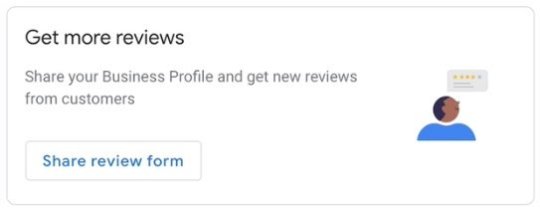
How you use that link is up to you. Some businesses ask for the review in exchange for a coupon, others do a campaign. You know what’s best for you.
Keyword Research
We’ve talked about how to spy on your competition using Ubbersuggest. But this keyword research tip comes from a different angle.
In this case, we’re going to use Yelp and Thumbtack.
Yelp
This tip is all about leveraging keyword suggestions so you can create content for those keywords.
All you do is type in the broad category of your business. For example, a dentist.
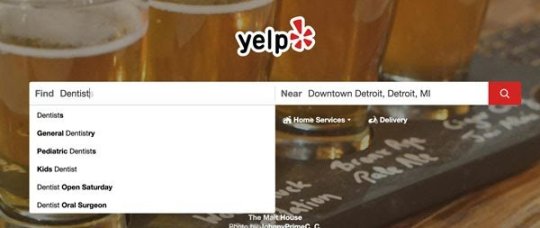
And see how the autocomplete bar shows you other things that people are looking for in this category. It could be services they’re looking for or something you don’t expect.
Thumbtack
The other website we can use for keyword research is Thumbtack, a search engine for professional service providers.
Again, type in the category of your industry or service, and see the autocomplete suggestions.
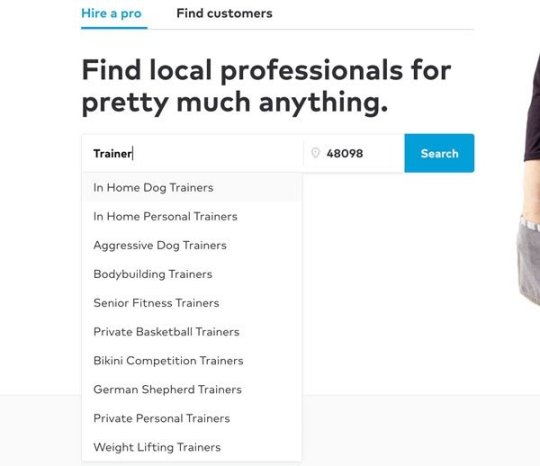
How to Structure Your Website
One of the most important tools for your local SEO efforts is your website.
Your website is the keystone of your online presence. And if you’re going to have a great website, you need great content that is focused around keywords and locations.
Based on the keyword research you did, you need to determine what keywords deserve a specific page (section) on your website.
So, once you decide, make sure you create a specific landing page for each location you serve.
The structure goes like this:
Keyword 1 + City 1
Keyword 1 + City 2
Keyword 1 + City 3
Keyword 2 + City 1
Keyword 2 + City 2
Keyword 2 + City 3
And so on…
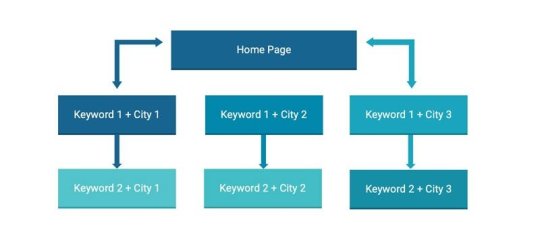
For example, and for the sake of brevity, let’s say a Mortgage Broker has these two services:
Refinance
New Home Mortgage
And if you’re in Michigan, let’s say you serve Troy, Birmingham and Clawson.
So you would need to create these sections
Refinance + Troy
Refinance + Birmingham
Refinance + Clawson
New Home Mortgage + Troy
New Home Mortgage + Birmingham
New Home Mortgage + Clawson
You get the idea.
This part of optimizing your website can get overwhelming. So don’t worry if you think this is too much. That’s why there are professionals who do this for you.
But if you are going to do it yourself, just make sure that the content you put in there is unique, useful and worth it.
Don’t just create a section because “you’re supposed to.” If you are not sure you can produce unique content for each section, it’s better to keep your website with fewer sections, but certain that all of them are great.
Conclusion
It’s a scary time but we can either retreat and hide or we can adapt and get stronger. If you business isn’t leveraging the internet for business, now is a good time to invest the time and/or money.
It’s simple to get your business optimized to show up in Google. Make sure your NAP is consistent across the WWW to boost Google’s confidence in your Google My Business listing.
Completely fill in your GMB listing and generate the special link for your customers to leave reviews.
On your website you want to spy on your competitors, use Yelp and Thumbtack for local keywords, and finally update your website structure to capture those keywords.
What industry are you in and what tactics do you use to get business from online mediums?
The post Local Business Optimization For Beginners appeared first on Joseph Paul Digital Agency.
0 notes
Text
SEO vs SEM:Which One Should You Use?
There are two ways to get traffic to your website from Google. Paid and organic. Also known as SEO vs SEM.
Paid Traffic happens when you pay the search engine, Google or other search engines, basically, so they show your website whenever someone does a relevant search. This is also known as Search Engine Marketing (SEM).
Organic Traffic happens when your website gets clicks for free because you have a piece of content so good that Google shows your website. This is known as Search Engine Optimization (SEO).
So which one is better? SEM or SEO?
Obviously, both require an investment.
You cannot expect to launch your new website, publish a couple of blog posts, and see hundreds of visitors pouring into your site. That’s not how it works. You need SEO to see organic traffic.
You have probably seen proof of this on your own website. It’s been up for a while, but it’s not getting any leads. If you’re a local business, you can use our free SEO audit tool to see what your local business could be doing to get more traffic.
On the other hand, paying for traffic can get costly and get zero ROI if you don’t do it right.
So the question is not which is better.
The question between SEO and SEM is which one is right for you?
The Difference between SEO and SEM
To understand the difference between SEO and SEM you have to know what’s in the Search Engine Results Page (SERP). Don’t worry, I know it’s a lot of acronyms to keep track of, but I promise that’s the last one.
The SERP has basically three parts:
Paid Results
Organic Results
Knowledge Graph Box (though this one doesn’t always show up)
Now that you understand that, we can see where everything goes.
What does SEM look like?
Think of a Google search you’ve done recently. Do you recall noticing how some of the results had the word “Ad” next to it?
That’s Search Engine Marketing for you.
Paying a search engine means you get to show up before the organic results on a search engine results page.
Remember the three parts of the Search Engine Results Page? Paid Ads go at least on top of everything else, and sometimes at the bottom of the list and even to the right.
Visually they’re almost exactly the same. The difference is that because those paid ads are the first thing people saw as a result of their search, it’s more likely that they’ll click on it.
How much does it cost me to run paid Google Ads?
There are a few ad campaign models you can test, but there it boils down to two ways:
Pay per click
Pay per impressions
We won’t go into detail with this, because we could write a book about this. But you can check out the Google Ads homepage for more info.
But essentially, Pay Per Click means you pay Google only whenever someone clicks on your ad.
Pay per Impressions means you pay Google for every 1,000 times they show your ad, regardless if they click on it or not.
Most recommendations go with Pay Per Click as the best bang for your buck.
Search Engine Marketing is very sophisticated, and I wouldn’t recommend you go in without some training or professional help. You can burn a decent amount of money very quickly and get no results.
When is SEM recommended?
Search Engine Marketing is the best at getting results quickly. You set up your campaign, put your credit card info in, and you can be running a campaign within minutes.
So if you need traffic to your website quickly, paid ads are the way to go.
SEM can be useful for basically anything time-sensitive. Think of products like events, limited-time sales, seasonal events, and things like that.
Paying to get quick traffic can work for you, especially in situations like that.
The downside is that the moment you stop paying, the ads stop, and the traffic stops.
What does SEO look like?
Back to our SERP (the results page, just a quick reminder) anatomy class.
SEO looks like organic results. The organic results section has far more variety and richness of content than SEM.
We may be biased but look at it.
Look at all those beautiful organic results.
When you invest in getting organic traffic, you can rank content like:
Blog posts
Videos
Maps
Reviews
Calls to Action
Tools
FAQ
Images
Charts
Catalogs
How long does it take to see results from an SEO campaign?
Yes, investing in SEO takes time. Usually, 3 to 6 months is the ideal scenario to start seeing results, but it all depends on your industry, who you’re competing against.
But the advantage of SEO is that once you rank something, whether it’s a blog post or a video or whatever excellent piece of content you produced, it’s going to be up there, generating juicy organic traffic for months, even years. For free.
When it works, it works.
And it only gets better.
Once you rank one thing, it’s easier to rank the second. And the third after that, and so on. The more content you rank, the more traffic you get, the more website authority you get, which leads to other sections being able to rank easier, which leads to more traffic and, well, you get the idea.
SEO has the advantage of having the potential for exponential growth. SEM doesn’t.
The only way to grow an SEM campaign is to put in more money.
The mindset of SEO vs. SEM
Because SEM costs you money every time someone clicks on your ad, you want that wherever that person lands after the click, converts into a potential customer.
So this is the part where we talk about your landing page.
How to Setup Your SEM Landing Pages
Another difference between SEO and SEM is where your visitors land. This is called Landing Page.
When you are paying for ads, the landing page is meant to convert. So the elements in it should be different. It’s supposed to be a bit more aggressive so to speak.
For this, you need great copy, clear calls to action, a fast loading page, content that generates trust so that your visitor does what you want them to do.
Something interesting to point out is that usually, a Landing Page of this type does not have a menu. This is so that whoever lands on this page literally can’t do anything but click on the button or leave.
The goal of an SEM Landing Page is for your visitor to convert.
How to Setup your SEO Landing Pages
SEO landing pages are different in that the primary goal is not to convert them to customers. SEO landing pages are there to build trust and convert leads.
You do this by providing free, useful, easy to read information.
You do this with well-researched articles.
You do this with awesome graphics and videos.
You do this by building useful tools they can use.
There are many things you can do to improve your local website ranking. Everything counts, and everything adds to the winning strategy.
So that when they decide to contact you, half of the sales process is done because you already gave them the information they need to make a purchase with you.
SEO vs. SEM, the Bottomline
There is space for both SEO and SEM strategies for any business. Most times, the best results happen when you are doing the two things at once.
But you need to understand what each strategy will give you.
SEO will give you:
Loyal Customers. They trust your brand. They didn’t just click your ad because you were offering the most attractive solution. Whoever offers something cheaper, bigger, flashier, will take your sale.
Build Authority. Since you’ve already given free information and displayed your knowledge in your field, you’re going to be viewed as an authority.
Continual ROI. Invest in SEO and whatever growth you get will continue to deliver for months or even years.
Easier Sales Process. Websites that invest in SEO have websites that give people useful information so that when they do call you, half of the questions they had were already answered on your website.
SEO takes time, a lot of research, and content creation. If you can afford to be patient, SEO is a long-term high reward strategy that lasts for a long time.
SEM will give you:
Fast Results. You put in the money, you get visitors. Your SEM specialist will handle optimization and making sure you are getting the right traffic.
SEM is faster to set up, but it needs a lot of testing and optimization. You can spend a lot of money just to get the campaign right. SEM is a strategy that can be profitable but can get expensive. And of course, the moment you stop the campaign, the traffic stops.
The post SEO vs SEM:Which One Should You Use? appeared first on Joseph Paul Digital Agency.
0 notes
Text
How To Get eCommerce Sales With SEO
Having an e-commerce site nowadays is easy. Dozens of platforms can get your online store set up in a matter of minutes.
The problem is that as it gets easier, the eCommerce space is more crowded than ever.
Even if you have your website ready to take orders, chances are you won’t get much if any traffic at all. So your options are ads on social media or pay per click campaigns on Google Ads.

And the other option, while it’s more of a long-term strategy, is content marketing, which, according to Demand Metric, costs 62% less to produce than ads
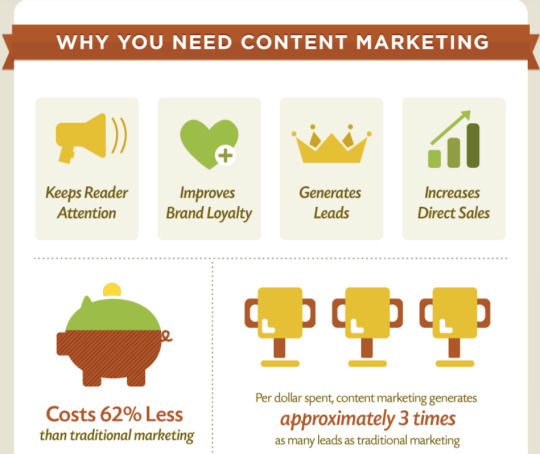
Should you abandon Facebook Ads or pay per click campaigns altogether?
No.
But SEO for e-commerce sites should definitely be part of a sustainable strategy to generate traffic.
We are going to take a look at five ways e-commerce sites can apply SEO tactics to improve their online presence and make ad-free sales.
All of these tactics are easy to implement and free. Most of these tools have a paid option to get more results, but for most people, these small but powerful tweaks can make the difference.
Let’s jump right in.
Keyword Research for E-Commerce
Keyword research is one of the most basic ways to optimize your site for search engines.
Targeting keywords still work on regular websites, and it definitely works for e-commerce sites.
In its most basic form, Keyword Research involves:
Finding how many searches per month a particular keyword has
Creating content that caters the intention of that keyword
There’s more to it, of course, but for e-commerce, you get to use two tools that will supercharge your keyword research efforts.
Amazon as a keyword eCommerce SEO research tool – Part 1
Ever meet a stranger and think, “I wish I knew what they were thinking?”
Well, your wish is Amazon’s command.
Amazon is the biggest e-commerce site in the world. And the search bar is a fantastic keyword research tool that not everyone takes advantage of!
Simply type in a broad category term in the search bar. For example, beard products.
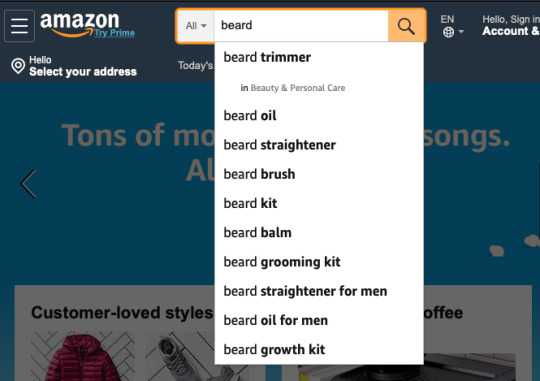
Even if you only write the word beard, Amazon will show you a list of searches people are currently using to buy items.
Did you get that?
Amazon will give you some of the most common ways people find things to buy on Amazon.
But Joe! I don’t sell my stuff on Amazon!
Yeah, but if people use a search term on Amazon to buy something, chances are they’ll use that same term in Google.
It would be wise to make that part of your eCommerce SEO plan.
Amazon as a keyword research tool – Part 2
The other way you can use Amazon as your keyword research tool is to go into a competitor product and read the reviews.
Notice what words people use to describe the experience and features of that product. Notice the pain points, what they do right.

Then, plant those words into your own product’s description. This way, you optimize your product descriptions into something that addresses their problems before they have them.
You can use this tip on eBay, Etsy, Home Depot, Walmart, etc. Any big eCommerce website will have a search bar and will give you keyword suggestions.
Honestly, Amazon and eBay will give you most of what you need. So don’t be surprised if there’s an overlap.
The best advice I can give you for keyword research is to go in, get what you need, and take action as fast as possible.
Otherwise, you can get easily overwhelmed with information and get decision paralysis.
Make it Easy to Purchase Your Products
No one wants to feel like a mouse in a maze trying to find cheese. So why would you make your visitors feel like this?
For e-commerce websites, there’s an unwritten rule that says that your products should never be more than three clicks away.
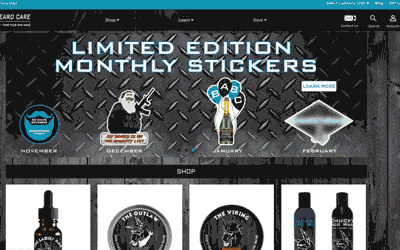
Make sure your website is easy to navigate both in desktop and smartphones, that your categories make sense, and that’s it’s just intuitive.
A good site structure to have is having your home page lead to a categories page. From the categories, have subcategories where specific products are listed.
Being three clicks away means that it takes two clicks to get to your product page.
Why? Because click number three is where the money is. Your ADD TO CART button should be click number three.
If your website is disorganized, I would recommend you work closely with an SEO.
An SEO will make sure that all the proper redirects are in place, so you don’t have dreaded broken links on your website.
Optimize Your eCommerce Product Page
In the context of your website, your product has three elements:
Product URL
Product Title
Product Description
Make sure that whatever keyword you decided you wanted to target is in these three elements.
For example, back with our beard products example. Let’s say we’re trying to target beard balm, and your product is a fantastic beard balm.
Your product URL must be:
myecommercesite.com/product/badass-beard-balm

Your product title must be something like:
Badass Brand – Beard Balm 5oz bottle
And your product description must tell us everything that makes this beard balm so amazing.
How to Write Product Descriptions
Product descriptions are everything for a product. So make sure you:
Describe what the buyer gets from getting your product. How their lives will be better. What problem it solves.
Bullet points, numbers, comparisons, features.
Include photos, video, graphics.
Pay close attention to bullet point one. Do not focus on features but rather the benefits those features bring to your customer.
Technical Tips to Write Great Product Descriptions
If you have two or more products that are mostly the same (ex. different sizes or colors). Instead of making one product for each variation, create one Variable Product with different attributes that modify the product.
If you must have two separate product pages for two similar products, make sure the descriptions are different. Do not copy and paste descriptions.
Make sure they’re at least 300 words each description, but I recommend using 500 – 1,000
eCommerce SEO Audit
Another thing you can do is do a website audit. A website audit will give you a list of things you can fix from a technical and content point of view.
It can get overwhelming, and you may need professional help for some things, but most of them are easy fixes.
To do a website audit, you can use Ubersuggest by submitting your website’s URL.

Once the tool loads your website, click on the Site Audit link to the left, and you’ll get a list of things you can start fixing on your site.
You can pay to get the full list, but the free version gives you enough to get started.
Content Marketing
Know that guy at the high school reunion that won’t shut up about how great he is now? That’s how people feel about content that is only about a company’s product.
Content marketing is about creating content that your audience finds useful. The goal is to create content that is related to the product, but not the product itself.
So, back to the beards example, content marketing is not creating a 1,000-word article about how excellent your beard balm is. That is what the product description is for
You should produce a great article about the best ways to keep a healthy beard.
The way to do it is simple.
You talk neutrally about ways to keep a beard healthy, and oh, by the way, we have a beard balm you can use. Here’s a link and a coupon. But you can also try this other thing you may have at home.
People love to buy, but they don’t like to be sold to. Content marketing takes care of this problem.
Be helpful, be excellent, and people will buy from you.
Create written content or video content. It’s up to you.
But Joe! I don’t know what to write about!
The best way to know what to talk about is to spy on competition or what people are saying.
You don’t need a hacker for this.
All you need to do is, search in forums related to your niche and look at the discussions that are going on. Go to Reddit, Quora, blog comments, the Youtube comment section (good luck there!).
There are hundreds of places you can find what kind of questions people are asking.
Find a question, answer it in a blog post or video, and you have a new piece of content.
**Bonus Tip** Use AnswerThePublic to see what questions people are asking around your product.
Get Backlinks
Let’s go back to your high school reunion again. In this scenario, you’re there, and you only casually talk about yourself.
Everyone else away from you is mentioning how awesome you are. Since the praise is coming external sources, it builds your authority.
Well, Google and potential customers think the same way. Essentially that’s what backlinks are.
Ranking in Google is kind of like a popularity contest. There’s just no way around it.
You can create the most exceptional content on the web about your product. Pour your heart, soul, blood, and tears into your blog posts and videos, and still get no momentum.
Why?
Cause no other website linked to your content.
Backlinks are like votes. The more links you get, the more you get noticed by search engines.
Getting backlinks is tricky. But here’s how you can get started.
Find a competitor’s website.
Steal competitor backlinks by using UberSuggest.
Once you have a list of other websites who already gave your competition a link.
Analyze what your competition did to earn that link. Maybe it’s a graphic, or a tool, or their product page is better.
I tend to do things to the extreme, so instead of only doing a little better, make your page 10x better.
For example, if your competition did a piece of content titled “5 ways to style your beard.” Create a topic that’s “50 ways to style your beard.”
Yes, it will be a lot of work, but the chances of someone trying to outdo you will be unlikely.
Then, reach out to the website who gave a backlink and see what you can do to get a backlink yourself.
Conclusion
It’s important to not overthink your SEO for your eCommerce website. Between your homepage, product pages, and content, there’s a lot of work to be done.
The best way to eat an elephant (so I’ve heard) is one bite at a time. Optimizing your eCommerce site is no different.
Start with setting your foundation with keyword research using Amazon and other eCommerce platforms.
Next, use the research to optimize your product pages’ titles, descriptions, and URLs.
Once you’ve done that, make it as easy as possible for someone to buy your products with the fewest clicks possible.
Uncover all the technical errors on your website to make sure it’s healthy. Once you have a healthy website create educational content, your visitors will love.
After it’s all said and done, it’s time to get others to share your website with the world.
What are some of your favorite eCommerce SEO tips?
{"@context":"https://schema.org","@type":"FAQPage","mainEntity":[{"@type":"Question","name":"What is your SEO philosophy?","acceptedAnswer":{"@type":"Answer","text":"We handle the technical, offsite SEO, and user experience."}},{"@type":"Question","name":"How will your SEO strategy integrate my brand?","acceptedAnswer":{"@type":"Answer","text":"Specific plan and process that handles this hurdle. Interviews and recordings is an example."}},{"@type":"Question","name":"Your SEO should ask what your goals are?","acceptedAnswer":{"@type":"Answer","text":"You’re looking for them to ask you this question and help you establish them."}},{"@type":"Question","name":"How long does it take to see results from SEO","acceptedAnswer":{"@type":"Answer","text":"Generally, 6 months, but many factors could cause it to vary. It’s important to get a timeline, and it’s ok if they’re off as long as they can prove progress."}},{"@type":"Question","name":"How will you deliver my report","acceptedAnswer":{"@type":"Answer","text":"You’re looking for a regular schedule and willingness to walk you through the metrics. The report should also include the next steps to improve them."}},{"@type":"Question","name":"What do you need from me","acceptedAnswer":{"@type":"Answer","text":"They’re going to need details about your brand, access to your Google tools, social media, and lastly, a meeting date to review the strategy."}}]}
The post How To Get eCommerce Sales With SEO appeared first on Joseph Paul Digital Agency.
0 notes
Text
Ask These 5 SEO Questions Before You Hire One
Remember making your first hire for your company? You were probably a bit nervous and lost about what questions to ask.
More than a little if you were hiring for a task that you’ve never done yourself.
We’ve all been there, and it shouldn’t paralyze your effort.
While I can’t help you hire your next CFO, I can help you hire an SEO agency or employee by asking the right SEO questions.

To help you out I’m going to arm you with 5 questions and their answers:
What is your SEO philosophy?
How will the SEO and Content Marketing Strategy Integrate Your Brand?
What are your SEO goals?
How long should it take to get results?
How will your SEO keep you up to date on your campaign?
Plus one bonus question
As much as it seems SEO is black magic, it really is a science with a hint of art.
Let’s dive into it.
1: What Is Your SEO Philosophy?
The first question is pretty straight forward; What is their SEO philosophy.
There are three types of approaches to SEO:
Technical – Handling the smaller details on your website like organizing pages titles, interlinking pages, handling backend code like schemas, and more.
Offsite SEO – Acquiring backlinks (citations to your website), distributing your content off of your website, and listing your business various directories if you’re a local business.
User Experience (UX) – Focusing on how delightful it is to be on your website and ensuring that your content is engaging.
Any of these approaches will certainly help improve your success with Google, but alone they won’t help you compete against strong competitors.
What you are looking to hear is someone that includes all three of these approaches when they propose working on their website.
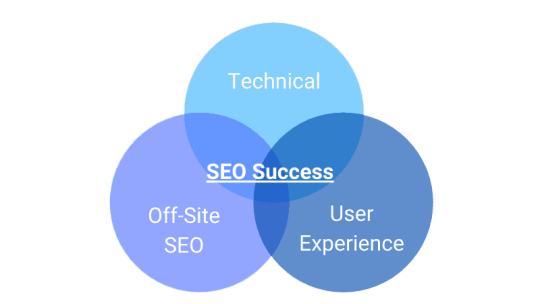
Think of it like a football team, it’s not the team with the best offense, defense, or special teams that win the SuperBowl. It’s the team that does all three good.
Not a sports fan? Then think of it like this…
Your website is your storefront. Technical SEO will make sure that your storefront (website) is maintained and running well so that it’s efficient for Google to navigate it.
The offsite SEO is your marketing team that’s telling the world about your website. The offsite SEO is getting backlinks, citations, and promoting your content off your website to create authority in Google’s eyes.
The User Experience is delighting your new visitors, making them stay on your website or what an SEO would call dwell time.
A user experience approach will reduce the number of people leaving your site quickly (bounce rate) by improving your site’s speed, design, mobile appearance, and relevance to the search.
About relevance to searches, imagine a building labeled as a grocery store, and you walk in to only realize it’s actually a shoe store?
You’d walk out right away because it’s not what you were expecting. That’s why it’s essential to have content your ideal client is looking for.
If you hit all three of these marks well, then you’re going to be in excellent shape.
If you want to see how these three pillars of SEO impact your local business? Moz interviewed several SEOs to what were the most important factors for rankings.
2: How Will The SEO Strategy Integrate My Brand
Picture this, you see a burger king commercial while watching your favorite show, and at the end of the commercial you hear “ba da ba ba ba I’m loving it.”
You’re going to instantly know that something is very off because that’s McDonald’s jingle.
Well, a good SEO should have a plan in place to make sure the content they produce for your website (they are creating content, right) is congruent with your brand.
Aligning with your brand will be a challenge, especially in the beginning, and they should have a plan in place to minimize the growing pains.
According to Bop Design, 45% of a brand’s image is created by what you say and how you say it.
2: How Will The SEO Strategy Integrate My Brand
Picture this, you see a burger king commercial while watching your favorite show, and at the end of the commercial you hear “ba da ba ba ba I’m loving it.”
You’re going to instantly know that something is very off because that’s McDonald’s jingle.
Well, a good SEO should have a plan in place to make sure the content they produce for your website (they are creating content, right) is congruent with your brand.
Aligning with your brand will be a challenge, especially in the beginning, and they should have a plan in place to minimize the growing pains.
According to Bop Design, 45% of a brand’s image is created by what you say and how you say it.

This isn’t a part of the strategy you want to gloss over.
Don’t have a brand? A good SEO should be able to iron out with you on the tone and feel of your content.
There’s no one right answer for a question like this. The important part is there’s a process to avoid going off-brand.
Our process is to generate topics based on Keyword research, propose the topics for approval, and finally request a call or voice recording of your perspective on the topics.
We then expand on our short conversation or recording to turn into a blog post. It later gets submitted to you for final approval before we let it fly.
3: What Are Your Success Metrics (Your SEO Should Be Asking)
If you’ve ever talked to an SEO and had a nickel for every time they mentioned “increased traffic,” then you’d be rich enough to retire.
Unless you’re running display ads, traffic is a vanity metric just like getting a bunch of young professionals visiting your website that’s meant for farmers only. That won’t do you any good.
That’s why your potential SEO should ASK YOU what your goals are.
SEO’s are borderline fortune tellers when it comes to keyword research, but your business is unique and has its own unique goals.

To drive the point home, let’s dive into two examples.
If we’re doing SEO for mortgage brokers, then your success lives and dies on the number of qualified leads you can get. To do that, you’re going to have to get a lot of the right traffic.
By right traffic, we mean you want people who are looking for mortgage services finding you. Having people contacting you looking to rent somewhere to live won’t do a Mortgage broker much good.
Another example is if you’re an author preparing to release a book about sales.
Unless you’re writing the book for a specific niche, you’re going to want to attract everyone interested in improving their sales.
On your site, you’re going to want to have a strong call-to-action to sign up for the newsletter so that you can email blast everyone who showed interest in sales that your book is released.
Notice how one person needed leads to contact right away while the other captured leads to contact when the time was right?
On the surface, they both need leads, but their use for the leads is very different.
Although your SEO should be asking questions relating to your goals, it is wise to come into the interview with goals in mind.
Here are some ideas from Moz:
Getting E-commerce sales
Getting as much traffic as possible
Creating a brand
Reputation management
Become an authority or influencer
My goal is to capture leads of potential clients for my SEO agency.
4: How Long Does It Take For SEO To Work
Remember the first time you went to the gym, and you left with a cover model physique, neither do I.
The analogy may sound silly, but in reality, it has a lot of similarities with SEO. Content Marketing and SEO are a long term play that can pay off big if you stick to it.
There is a huge list of factors that go into how fast your website can rank. Ahrefs did a great job of breaking it down.
You’ll see based on their study of 2 million random pages from their database that only 5.7% of website rank in the top 10.
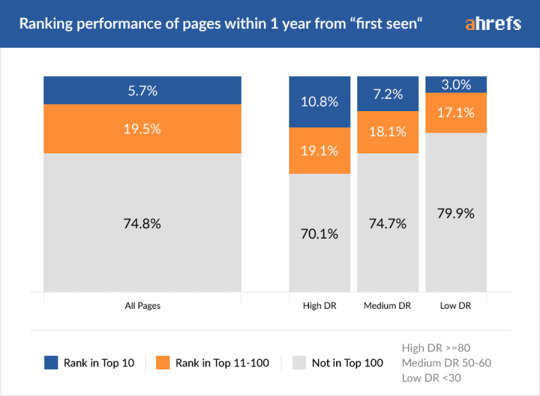
The more authoritative websites clearly show Google has a biased towards them, but…
When you look a bit deeper into the timing of their rankings, you’ll notice in the graph below that in the 180-day range (roughly 6 months), the lower authority websites managed to make it to the top 10.

Although there many factors that go into how fast your website will rank in Google, a good rule of thumb is to expect to wait at least six months.
The timing also varies with industries and competition, so it will be a good idea to get a second opinion.
A red flag to avoid is an SEO that won’t provide you with an estimate.
I can promise you the SEO won’t hit it right on the nose, but they shouldn’t be too far off.
Being wrong is ok as long as they can show the progress being made, which brings us to the next point…
5: How Will You Report My Results
When you’re interviewing your potential SEO, it’s important to understand how they’re going to deliver reports.
Just as important as delivering reports, it’s important to understand how they provide it.
You can give me a book written in Japanese, and I wouldn’t be able to gain any value from it because I don’t speak or read Japanese.
You’re not an SEO, and if an SEO report were to hit your inbox right now, you wouldn’t understand it.

Your SEO should interpret what the data means and what actions it will be driving the following month.
The first few months of these reports will be dense for you.
After month three, it will begin to be less dense, and the meetings will be more efficient.
The real value you’re trying to uncover here is transparency. Any SEO that is vague or cryptic is likely hiding something.
BONUS: What Do You Need From Me?
This is a bonus question for that isn’t intended to qualify your SEO but to ensure a smooth start.
Ask your SEO what they will need from you to get started. If their answer is your money, run for the hills.
Some items they’re likely to ask for, and you should be ok with is the following:
Raw files of logos, designs, and brand books to ensure they’re creating graphics congruent with your brand.
Access to Google analytics, search console, and Google My Business. Do not give them your password but provide them with access by following these instructions.
Access to the backend of your website or contact information of your developer.
Meetings dates to go over the Keyword research, content strategy, and topics.
Access to social media accounts to integrate them with your website and Google assets.
It’s important to note that you should not be giving them any of your personal login information.
In the first month or two, your SEO will likely be borderline annoying because they will be asking a lot of you. It’s required to do their job well.
Bear with them because once it’s ironed out, a good SEO can be treated like a rotisserie chicken, set it, but don’t forget it.
From there, you should be hearing from them about once a week or every two weeks with updates or questions.
Conclusion?
Hiring is hard, especially when you’ve never done the task yourself.
Knowing the right questions to ask is critical to cutting down the learning curve significantly.
You want to make sure you ask the following SEO questions and receive relative answers:
Q: What is your SEO philosophy A: We handle the technical, offsite SEO, and user experience.
Q: How will your SEO strategy integrate my brand A: Specific plan and process that handles this hurdle. Interviews and recordings is an example.
Q: Your SEO should ask what your goals are A: You’re looking for them to ask you this question and help you establish them.
Q: How long does it take to see results from SEO A: Generally, 6 months, but many factors could cause it to vary. It’s important to get a timeline, and it’s ok if they’re off as long as they can prove progress.
Q: How will you deliver my report A: You’re looking for a regular schedule and willingness to walk you through the metrics. The report should also include the next steps to improve them.
Q: What do you need from me A: They’re going to need details about your brand, access to your Google tools, social media, and lastly, a meeting date to review the strategy.
Are there any practical questions I may have missed that would be useful to ask an SEO? Let me know in the comments.
The post Ask These 5 SEO Questions Before You Hire One appeared first on Joseph Paul Digital Agency.
0 notes
Text
4 FREE Ways for Spying On Your Competition’s SEO
It doesn’t have to be difficult or complicated to get started on an SEO journey.
Not knowing where to start is a normal feeling to have, and a lot of times can put you off from starting.
For starters, you have competition who likely motivated you to begin taking SEO seriously.
That means they have a head start on you.
Don’t worry – that’s excellent news.
Having competition who had a head start with SEO makes your life easier.
You should send them a thank you card for making your life easier. All you need to do now is emulate and improve on their strategy.
It’s easy to do once you have the right tools, and you know what to look for.
For our SEO Services, we use tools like ahrefs and SEMrush, which both start at $99 a month, and we pay way more than that.
We have to afford to do that because SEO and content marketing is what we do.
You don’t have to break the bank upfront to begin your SEO strategy. You can get started for free.
We’re going to explore how you can leverage free tools to look at your competitor’s strategy on each of these fronts:
What Keywords They Rank For
What Content Is Working Best
What Search Terms Are Profitable
How Often They Post
What Titles You Should Use
If you were going to try to figure this out all on your own, you would be reading a handful of SEO guides and would likely be persuaded to buy unnecessary tools.
You would be getting conflicting advice and self-serving recommendations.
I was there when I was first learning, and I have to admit I likely lined someone else’s pockets because they pushed a tool that I didn’t need (yet).
I don’t want you to waste time or money I did.
That’s why I’ve created this guide to uncovering your competition’s SEO strategy with free tools.
youtube
#1: WordPress SiteMap
According to Whois Hosting This, 455,000,000 self-hosted websites are on the WordPress platform.
Odds are your competitor’s website is on WordPress also. Of those websites, they’re likely one of the 7,412,434 sites using the Yoast plugin.
What you can take advantage of is that Yoast has the same URL structure for every sitemap.
A sitemap is a blueprint that shows Google crawlers, where every page on your website is to help Google crawl your site faster.
We take advantage of this by quickly uncovering pages and categories a website uses.
The way to get to a website’s site map is to type in their domain like this:
competitor.com/sitemap.xml
You should see something like this come up next:
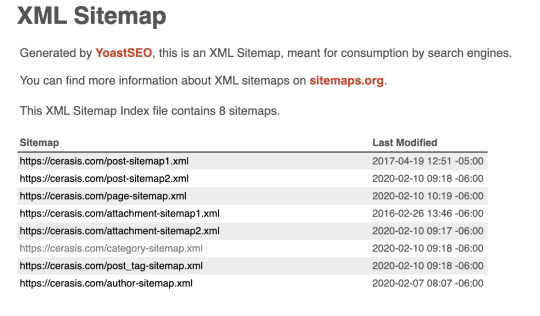
Looking at a sitemap could get overwhelming for a large website, but for smaller or local sites, it’s a great way to uncover service location pages.
#2 Ubersuggest
I cannot speak highly enough about UberSuggest. UberSuggest is the tool I wish I had when I first began my SEO and Content Marketing Journey.
Before UberSuggest, I had to pay for tools like ahrefs and SEMrush (when I couldn’t afford it) and scraped by to get access.
Neil Patel put together a tool that’s 100% free to use and gives the services above a run for their money.
In case you don’t know, Neil is one of the world’s leading SEO/Content Marketers.
I learned the majority of my content marketing and SEO techniques by working directly with Neil and his team.
Some of the advice here actually comes straight from him (sorry, Niel :-P).
Ok, let’s get into the nuts and bolts of how to use UberSuggest to it’s fullest.
Steal your competition’s keywords
Take your competitor’s URL and paste it into the search bar on the screen.

The first thing you’re going to see is your competitor’s SEO stats like traffic, keywords, domain score, and backlinks.
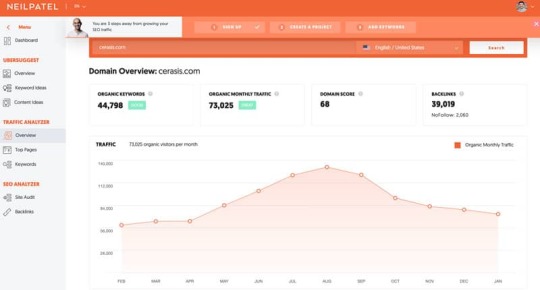
Click on top pages to see what content is performing the best for them.
Once the page loads, click on view all under the Estimated Visits column, and now you’ve uncovered all of the keywords that page is showing up for in Google.
Now you can go through their best pages and start to place them into your keyword research document.
Now create content that targets these keywords and create something better than what your competition created.
Steal their backlinks
Backlinks are when a website cites your website for information. Think of it as a vote for your content.
These votes get tallied by Google to establish how trustworthy your website is.
Not all votes are created equal, though. The more relevant the citating website is to your niche, the more influential the vote.
How are you supposed to find relevant websites out of the 1.74 billion sites that exist on the internet, according to Web Hosting Rating?
That’s easy, under the backlinks column on the same screen, press View All and it provides you with a list of everyone who’s linked to the content.
You know the keywords already, and you’ve created content that is better than their content.
It’s time to approach the websites which are linking to your competitor and say something along the lines of:
“Hey, Website Owner – I noticed you are linking to an outdated blog post about XYZ. I recently expanded and updated that topic to be more current, and I think your visitors will appreciate the most up to date info.”
On the surface, this might not sound that exciting, but consider this.
Your competitor didn’t know who would link to them and likely reached out to 100’s of people to get those links.
They’ve done the hard work for you by finding these websites interested in the blog post.
If your content is better, up to date, and expanded, they have no reason not to link to you.
You’ve now successfully stolen a link from your competitor.
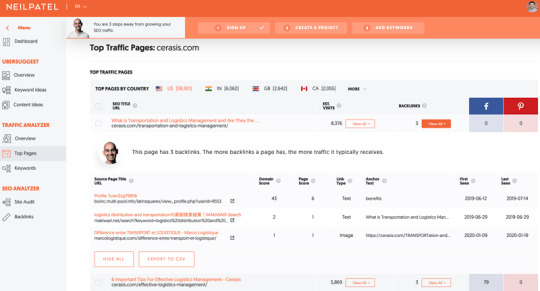
It’s time to approach the websites which are linking to your competitor and say something along the lines of:
“Hey, Website Owner – I noticed you are linking to an outdated blog post about XYZ. I recently expanded and updated that topic to be more current, and I think your visitors will appreciate the most up to date info.”
On the surface, this might not sound that exciting, but consider this.
Your competitor didn’t know who would link to them and likely reached out to 100’s of people to get those links.
They’ve done the hard work for you by finding these websites interested in the blog post.
If your content is better, up to date, and expanded, they have no reason not to link to you.
You’ve now successfully stolen a link from your competitor.
#3 Screaming Frog
This next trick will show you which pages are most important to your competitor.
We are going to use a program called Screaming Frog.
Screaming Frog is a software that crawls your website or your competitors in this case and gives you a bunch of information.
When you first see the information, it can be overwhelming because you likely won’t know what most of it means.
That’s ok because we want to gather the purposeful information.
In this case, the purposeful information we are looking for is what pages matter most to your competition.
Download Screaming Frog to your computer then launch and type in your competitor’s URL:
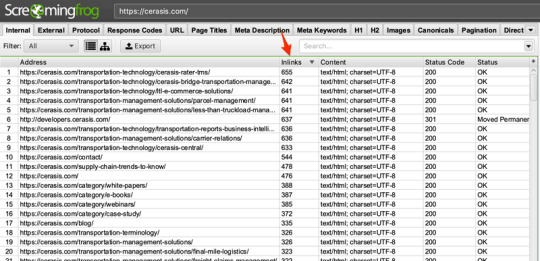
Go to the filter button and select HTML. Scroll to the right until you find the column “InLinks” and sort it from highest to lowest.
At the top of the list will be the pages that your competitors internally link to the most.
Think of your competitor’s site as if it were a museum or amusement park. Once you get in, you can’t get out without going through the gift shop first, where you might spend some money.
The concept is the same when it comes to websites. Your competition is going to do their best to guide their visitors to the pages where they can pitch their products.
Once you uncover these pages, you can see what their offer is and how they’re making the offer. From there, you can emulate their layout, sales angle, and calls to action.
#4 Google
How many times have you heard, “Google it?”
According to Hubspot, they estimate Google handles 5.8 BILLION searches a day.
Odds are you’ve likely heard the phrase once or twice a week. Well, keeping up with your competition is not different.
What we are going to show you is how often your competitor is creating content for their website.
Most people don’t know this, but You can dictate how Google performs your searches with special commands.
Here’s how you do it:
First type into Google’s search box, your competitor’s URL with “site:” in front of it.
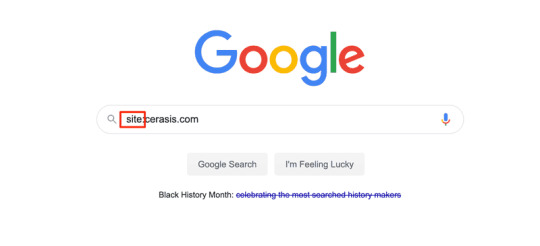
The command told Google you want to limit all the results to your competitor’s domain only.
Once the results come up, under the search bar, you can to click on the tools button.
Once you’ve done that, you’ll see two more buttons appear, “Any Time” and “All Results.”
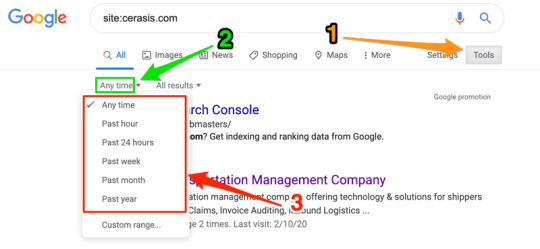
This shows you the amount of effort your competition is putting into SEO by how frequently they’re posting to their website.
From here, you have a few choices.
You can decide if you want to match, exceed, or do a little less than what your competition is doing.
There is no right answer here because, ultimately, frequency, along with quality, and many more factors play into Google rankings.
If you have the resources to meet or increase the frequency of your competition’s production rate, I would suggest it.
If you cannot, don’t sweat it. Just make sure you remain consistent and provide quality content.
#5 Ngram Analyzer
Ngram analyzer is an online analyzer that helps you take a handful of titles and find patterns.
What it does is it looks through the titles, and you ask it find strings of words that often go together.
Ngram Analyzer will provide you with is an idea of what type of content your competition is creating and how they are titling their content.
With the help of UberSuggest, we can export all of the top pieces of content to excel.
Copy all the titles from Excel and paste them into Ngram Analyzer.
I first start very narrow and use 4grams, which is a string of four words that are together more than once.
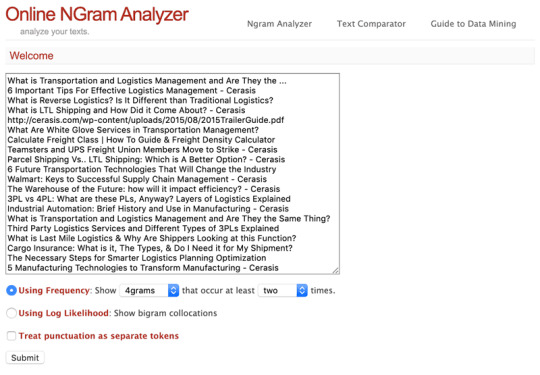
You should see results like this, which are terms and the number of times they show together.
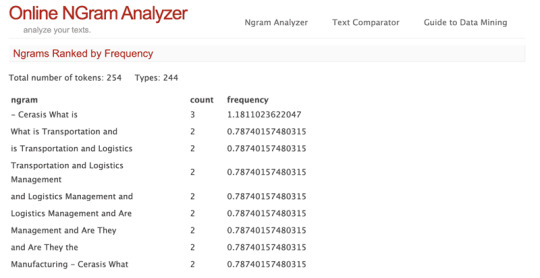
In this example, you can see phrases like “is transportation and logistics” and “transportation and logistics management” are important to them because they string them together a lot.
You can go further by broadening the criteria to 3gram and 2gram to see if you can gain any more insights.
You should see results like this, which are terms and the number of times they show together.
Conclusion
You may not be an expert in SEO, and that’s ok because you don’t have to be to develop a decent strategy.
If you know how to spy on your competitors for free, you can see what’s working for them.
Use the free tools we mentioned above, along with my strategies, and you’ll quickly uncover what they are doing right.
The post 4 FREE Ways for Spying On Your Competition’s SEO appeared first on Joseph Paul Digital Agency.
0 notes
Text
The Ultimate Guide to Optimizing Your Website for Mobile
How addicted are we to our phones?
Well, for starters, recent research reveals that 50% of smartphone users check their mobile phones first thing in the morning. And another study showed that as of 2018, 52.2% of all global website traffic was generated via mobile devices.
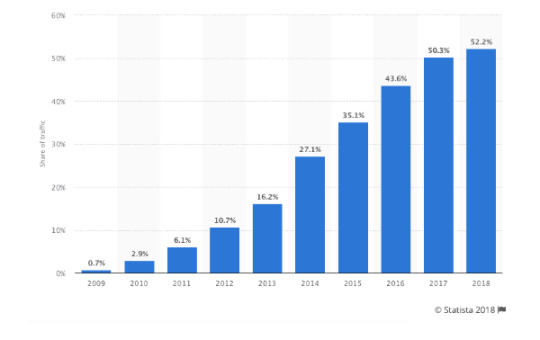
This is great news for your brand and website. Consumer love for mobile devices makes it easier for your prospective and current customers to access your website.
But if you want to make the most out of this global love for smartphone usage, you’ll need to optimize your content and website for mobile traffic.
Without optimization, you’ll be losing out on massive traffic. Google has stated severally that it wants to serve its users mobile-friendly websites.
This makes optimization a must, as not only will it help your SEO but it will also boost user experience on your site, which will ultimately reduce your bounce rate.
With that said, let’s see some quick definitions and then how you can optimize your website for mobile.
A Brief Description of Mobile-friendly
A mobile-friendly website simply means a site that appears well not just on personal computers but also on mobile phones. That means users can easily click the navigation elements and links on the website, and the text on each page is visible enough to be read.
“Mobile friendliness ensures that visitors can properly consume your site’s content when using mobile devices.”
To know if your site is mobile friendly you can use Google’s free mobile-friendly test tool, which will show you what aspects of your website you should optimize for adequate mobile compatibility.
To do this type in your site’s URL and hit run test

View the results:
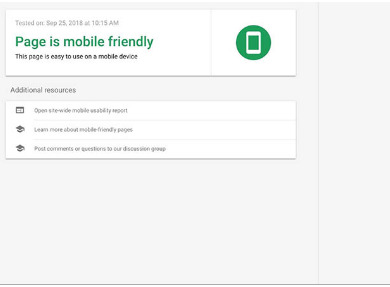
or:
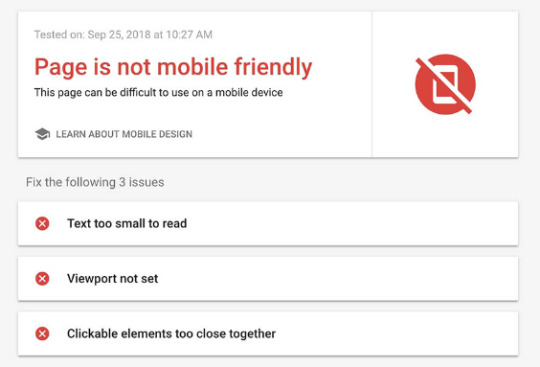
Next, click on “page load issues” and scroll down for more details:

A Short Definition of Responsive Design
You may have probably come across the term “responsive design”. It is generally used to mean a mobile-friendly design; however, that’s a misconception.
There are numerous ways to create mobile-optimized websites, and utilizing a responsive design is just one of them. Responsive designs simply adjust the content of a webpage to the
14 Ways to Optimize Your Website for Mobile
1. Improve Site Speed
Studies have shown that 53% of visitors will leave a website that takes over 3 seconds to load. That means you can lose more than half of your traffic if your webpage loads slowly.
Check out the visual below, the bounce rates rise as the page load time increases:
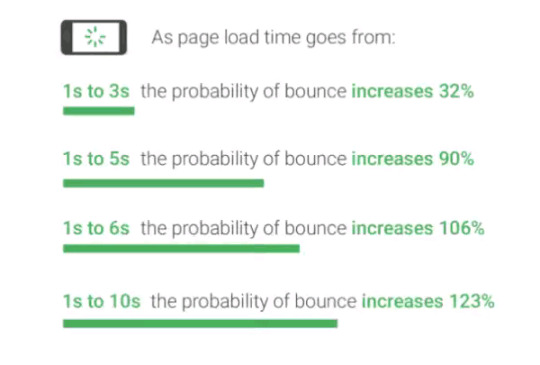
To avoid this and try to keep your page loading time below 3 seconds, you can simplify your design by eliminating heavy images and unnecessary design elements. The first step, however, is to test your site’s mobile speed and Google has the best tool to help you with that, the mobile speed test tool.
All you’d need to do is type in your site’s URL and then click the arrow button:
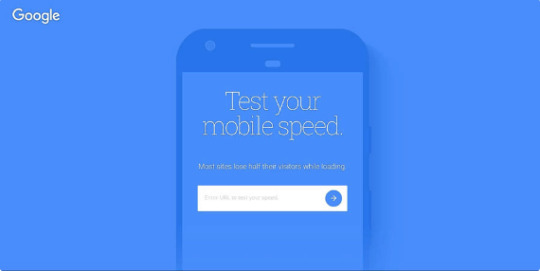
The tool will then scan your website and analyze how fast it loads on mobile devices:

If you want more information, you can scroll down and see how well your site’s speed does against your competitors, and the number of seconds you could take off your loading times.
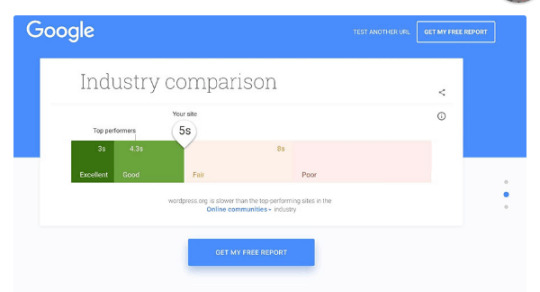
Here are a few ways to optimize your site load performance based on the results of the mobile load test:
Use Caching: When you implement caching, most of your website files will be saved on each user’s device, which ensures your pages don’t have to be downloaded every time visitors access a new page.
Go with a Content Delivery Network (CDN): A CDN allows you to store copies of your files in a series of servers that are in different geographical locations instead of delivering them from a single central server. The effect of using a CDN is that your load time would be the same for all users regardless of their location, while cutting down on your bandwidth usage.
Compress Images: Most times large image files are behind slow loading times, so you’d want to reduce their size by compression. By compressing them, you can decrease image size without hampering on quality.
Minify Your Site’s Code: By optimizing your websites Javascript, CSS and HTML code you can shave off seconds from you load times.
2. Use Simple Menus
When designing your sites menu options, keep in mind that mobile screens are smaller than desktop or laptop screens. Your desktop website can have extensive menus with many options but on a smaller screen, such elaborate menus can complicate things.
You wouldn’t want your visitors to have to zoom in and out or scroll just to see the navigation options. It needs to fit into their screens.
Check out this example from shareaholic:

That’s how the brand’s website menu looked before optimization. Navigation would be near impossible to the user, as they’ll have to zoom out to see their choices clearly or zoom in to see the menu properly.
If this is how your website appears on mobile devices your bounce rate would probably skyrocket and you’ll lose prospects.
Now look at the menu optimized for mobile:

The brand was able to cut down the complexity of the previous menu to a simple menu option. The options fit properly on the screen and the user can easily navigate to their desired page.
Evaluate your website and optimize it’s menu options for mobile visitors. Also, except if you’re using the kind of sidebars in the image below:
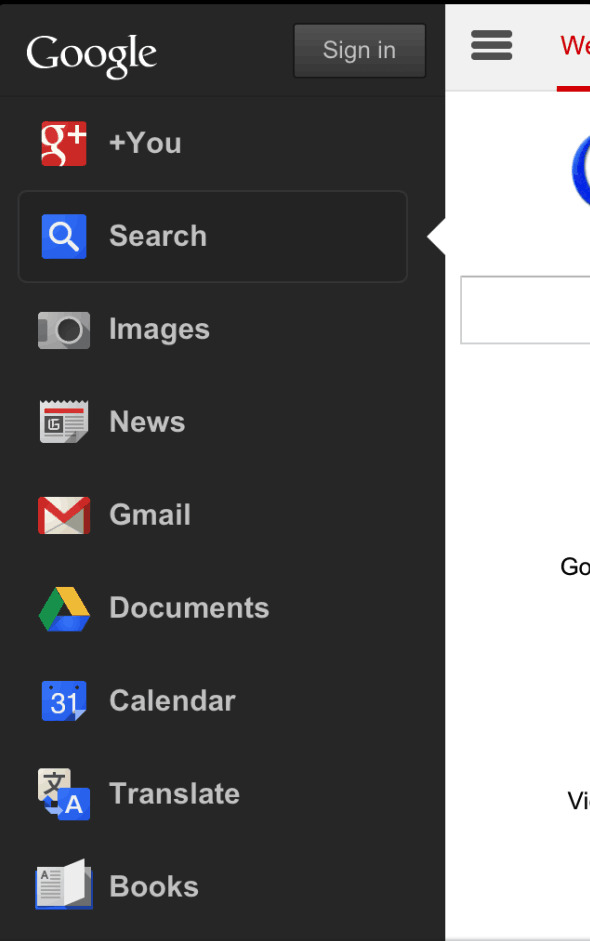
3. Use Short Forms
Check all the forms on your site for irrelevant lines. If you’re asking mobile users for too much information, it’ll hurt your conversion rates. Rather, ensure your forms are as concise as possible.
When desktop visitors are filling out forms on your website, long forms won’t be an issue, because they’re using larger screens and can navigate smoothly. But with tablets and smartphones, this won’t be the case.
For instance, if you have a form on your webpage asking visitors to subscribe to a newsletter, you don’t need lines on the form asking for their phone numbers and street address.
Forms for sales conversion should not include lines for irrelevant questions. Just ask for shipping and billing address. Data even shows that complex checkout processes initiate shopping cart abandonment:
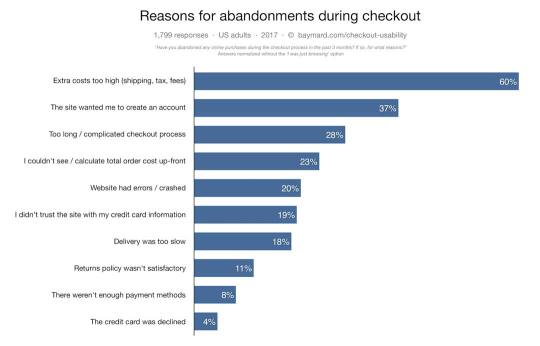
To avoid frustrated users hitting the back button, optimize your forms for mobile.
4. Have Clear Call to Actions
53% of websites use a call to action that takes users 3 seconds to identify. That’s way too much time.
For your mobile design to be effective, your call to action buttons needs to visible. Since mobile visitors are on smaller screens, you don’t want to overwhelm the user with numerous CTAs on the screen.
Whatever the primary goal of your landing page is, that’s what you should focus your CTA on. Are you gunning for new subscribers? Sale conversions? New downloads? or a boost in your social media following?
The exact goal is what your CTA should be about and has to be visible to the user in one or max two seconds.
5. Add a Search Bar
Remember the bit about menu optimization?
This relates to it.
If the desktop version of your website has a menu with many options, it may seem difficult to make it concise enough to fit into a single page on mobile devices. But it can be done, by including a search bar to the mobile version of your site.
Motivating users to search for their queries eliminates the need for you to depend on a complex menu. When you give visitors too many options, it could negatively affect your conversions because you’ll end up confusing them.
Take, for example, retail giant Amazon, they offer users more than 12 million products but don’t use complex menus because it’ll be impossible to display all those products on a single screen, so they use a search bar.
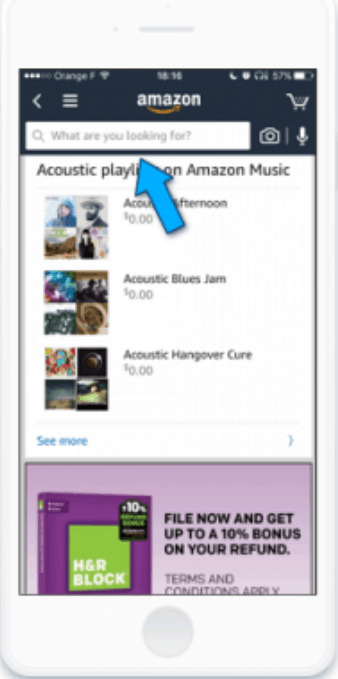
Use a search bar to break down complex menus and boost user experience on mobile devices.
6. Resize
For desktop visitors, browsing through your website can easily be done by controlling the cursor with a keypad or mouse but for users on smartphone devices, navigating with their thumbs it isn’t as easy.
Screen size is something you must keep in mind when placing different elements for your mobile page. Icons need to be big enough, so visitors can tap them with their thumbs. Also, ensure you leave enough space between each icon or button so people don’t accidentally tap the wrong one.
The right placement of buttons on the screen will increase the quality user experience. You need to place clickable elements where their thumbs can quickly access as 75% of smartphone users tap the phone screens with their thumbs.
Here is an image that shows the right to place clickable buttons:

Try to avoid placing them at the corners of the screen because it’ll be difficult for people to access those areas with their thumbs when holding a phone. The best place to put icons is close to the center of the screen.
7. Use a Responsive Theme

If you’re looking for a quick fix then changing your theme to a responsive one entirely will be an excellent option. For an established website, this may not be the best step but if you’re just getting started or still getting low traffic, then changing your theme to a responsive one is an easy solution.
If you use WordPress, you can easily change your theme by navigating to your WordPress dashboard and click on ‘themes’ under ‘appearance’ and then click ‘install themes’.
Type in responsive and search, the search results will show you all the responsive themes in the WordPress database, pick the one most relevant to your website and install it.
8. Get Rid of Pop-ups
Eliminate pop-ups on the mobile version of your site. Most web users do not like pop-ups, as they are annoying and negatively affect user experience. A major issue with pop-ups on smartphones and tablets is how hard they are to close.
Keep in mind that people would be clicking with their thumbs to tap a tiny “X” button to cancel a pop up on a small screen which can be frustrating.
Visitors may even end up clicking on the ad while trying to cancel it, which will take them to another landing page and ultimately make you lose potential leads.
Users may sometimes try to zoom in on the “X” to tap cancel but then the dimensions of the screen may not adjust properly, making for horrible user experience.
The best approach to handling pop-ups is to remove them altogether. Try out other methods to promote whatever it is your pop-up is showing users.
If you do decide to keep popups on your website then you need to do a lot of testing to ensure that mobile visitors can easily navigate away from it if they choose not to engage with it.
Other than eliminating popups from your mobile site, here are other alternatives to handling the popup problem for phone users:
Make them Simple: The first alternative is to simplify the popup form (assuming it’s an opt-in form) and ensure that it’s easy to cancel.
Only Use Onclick Popups: This is the best alternative solution of the two. The idea with this is that the popups come up only after the user clicks on a certain CTA. To achieve this you offer visitors a lead magnet and ask them to click it if they want to get it. Once they do, a pop-up will appear and request their details.

Web users are a lot more receptive to these kinds of pop-ups because they asked for it.
9. Use Accelerated Mobile Pages (AMP)
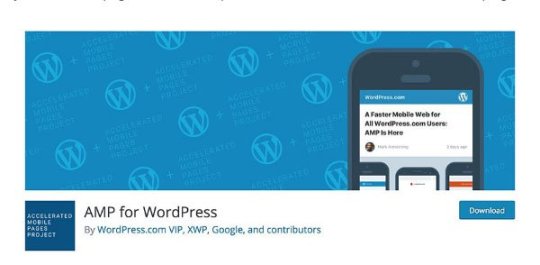
Accelerated Mobile Pages (AMP) was created by a collaborative effort of Google and other major brands to boost user experience for mobile users. These are still HTML/javascript pages but they load fast for mobile users, which is why Google encourages website owners to implement them.
AMP is a method for developing mobile-friendly versions of your website’s pages. It involves stripping down the site’s content and eliminating irrelevant media files and elaborate layouts. When users access your site with a mobile device these AMP versions will be served to them.
Is it compulsory that you make AMP?
There’s no definite answer because on one side it’ll help you attract new visitors and give your mobile visitors a great experience, but on the other, you’ll need to have two versions of your site.
If you’re using WordPress, it’s a lot easier because you can just install a plugin to enable it.
10. Don’t use Large Blocks of Text
While you’ll need to use words to effectively pass your message across to your visitors, try to keep them as concise as possible. Large text blocks can easily overwhelm the reader, and remember that if a paragraph is 4 lines long on your site’s desktop version, it could be 8 or 9 lines long a phone.
Focus on user comprehension and the ultimate goal of the page when creating your text to ensure users don’t have to stare at large chunks of text.
Conclusion
If you haven’t optimized your website for mobile users you’re missing out on a lot of traffic and potential leads.
You should properly optimize your website for smartphone and tablet visitors and to do this effectively you need to follow certain guidelines such as improving load speed, resizing images, enabling AMP pages and using a responsive theme, etc.
You must also keep in mind that people using mobile devices use their thumbs to tap on icons and buttons, so your placement needs to be where they can easily reach with their thumbs. Just follow the tips in this guide and you’ll effectively optimize your site for mobile.
If you have any experience or tip about mobile optimization, you’ll like to share with us comment below!
The post The Ultimate Guide to Optimizing Your Website for Mobile appeared first on Joseph Paul Digital Agency.
0 notes
Text
8 Mistakes I’ve Made As An SEO [And How To Avoid Them]
We’ve all heard “a wise person learns from their mistakes, while a wiser person learns from the mistakes of others.”
Today I’m hoping that I can make you wiser about SEO by learning from my mistakes.
When I first got into SEO it was because I was looking to promote my iPhone app and was looking to spread the word about it.
I was probably a lot like you, trying to figure out how to use Google to get in front of my ideal customer to create awareness around your business.
If you’re starting from ground zero, you probably can’t tell good information from bad information. It’s not something to be embarrassed about because we all started somewhere when learning a new skill. To be honest it happened to me.
In this article, we are going to try to help you prevent the hardships of being de-indexed by Google or spending a bunch of money with “experts” who don’t get results.
We know that ranking well in Google could take your business to the next level with warm leads who are looking for your products and services. Knowing what not to do is just as important as knowing what to do.
These mistakes can be bad but the good news is they are very easy to avoid.
Learning From The Wrong People
We touched a little bit on getting malicious and misinformed SEO advice. Avoiding misinformed advice is simple, don’t take advice from people who don’t practice SEO consistently or aren’t in the industry.
To put what I said into perspective, who would you take money advice from, Warren buffet or your uncle Larry who’s living paycheck to paycheck? I trust you know the right answer.
The malicious advice is much harder to avoid because sometimes this advice is spread by “experts” who can show you results and are running their own agency.
This is the trap I fell into when I first got started to learn SEO. You’ll notice that a lot of the early mistakes I made in my career were rooted in this simple mistake.
I don’t want to burden you too much around this because the next three mistakes I talk about later were all learned from these band of characters who taught hundreds of people (maybe thousands) of people these outright unethical tactics.
I put a lot of thought into whether I should mention their names or not and ultimately I decided it’s best I don’t give them any more publicity than they already have.
To help you avoid learning from these band of characters, I will give you the tools to avoid them and provide you with good sources information.
A way to weed out malicious “experts” is to ask yourself the following questions:
Is this person promising instant results?
Do they mention the word shortcut or fastest way to do SEO?
Do they focus only on keywords and promise number one ranking?
Do they oversell the ease of their methods?
Are they teaching an “advance” tactic that very few know about?
If you answered “yes” to any of these questions then you’re likely dealing with someone who is selling you snake oil that will likely work in the short term and sink you in the long-term. If it were this easy everyone would be an expert SEO.
The general rule of “if it’s too good to be true then it is” holds true here.
Below is a list of amazing people to learn from but before I introduce you to them, I want you to notice that all of these sources give an abundance of free information that you could use. The snake oil salesmen aren’t willing to do that.

Brian Dean – Brian from Backlinko is a great resource for those looking to learn how to build backlinks in a safe and organic way.

Neil Patel (doesn’t always look this serious, sorry Neil) – This is a person I personally invested money into to learn about content marketing and SEO. Neil has a way of simplifying complex topics and making it actionable. He focuses on the broader topic of digital marketing.

Search engine land – Want to keep up on Google algorithm changes and SEO news? Search Engine Land is usually always first to break the news and how it could impact your website.

MOZ – Great local SEO resource that will help local businesses navigate SEO if you’re a brick and mortar store looking to get more foot and website traffic.
I’ve spent years reading their articles and implementing their advice for years. The basics rarely change (they evolve) and all four of these resources always keep the basics in mind.
You might go to their websites and feel a bit overwhelmed by the amount of information (I was) available. You can sign up to get a free SEO checklist that will give you the basics in an organized manner.
Looking For Shortcuts
When I first started to learn SEO for myself and my web design agency, I wanted to learn how to show up in Google for searches relating to web design.
I was hungry to get results but not hungry to do the work required to get those results. So I took shortcuts taught to me by the snake oil salesmen under the guise of “everybody” is doing it.

I am here to tell you that everyone who won’t be around for long is doing it. As a matter of fact, a lot of these people are no longer teaching SEO.
First thing I learned from them (and later unlearned) was how to create a personal blog network (PBN).
A PBN is a network of websites that were purchased for the sole purpose of linking to your business website.
I would go out and purchase expired domains who have a history of being indexed by Google only to rebuild them to blog on them. On this blog, I would create content around the web design topic and shamelessly link back to my business.
The results came but they didn’t last long because it didn’t take long for Google to figure out what I was doing and tank my website. Most SEO’s won’t admit they made this mistake but if I never talk about it then you won’t have the chance to learn from it.
Another malicious tactic taught was to go to “link farms” and pay them to put your link on their website. A link farm is a website that has a bunch of links on their site and charges others to place their link on the site.
Why is this really bad for your website you might ask? That’s because one you’re usually charged a lot for link placement and you can’t control where or how your link is placed.
If you’re a dentist who is trying to generate more relevant traffic, it’s not a good idea have your link in a place around spammy links that have to do with prescription drugs, cheap designer stuff, and etc.
Although I never practiced this, it’s important to know it’s wrong.
Now we know how not to get links, let’s talk about how to get them.
The right way to get backlinks is to create great content that is helpful, establishing relationships with people who visit your site and influencers who relate to your niche.
Once you’ve established a relationship with these people you can ask them to link or share your content.
I know this may seem very time intensive (it is) between doing research and reaching out to these influencers or related sites but you automate the outreach if you use a tool like Mailshake.
Mailshake will mass send emails for you and has a lot of great pre-loaded templates to help cut down on emailing for relationship building.

Expecting Instant Results
Another poor habit I learned was expecting results to happen overnight. I think this is one of the biggest mistakes you can make because it really hurt my drive.
I would try something and not see results right away. The next thing I would do is get discouraged by the lack of results and walk away from SEO only to pick it back up after a few months.
This is a lot like doing one workout and then quitting because you don’t have six-pack abs immediately after.
What I needed to learn was that SEO isn’t an event but a process which means that you need to put in consistent effort day in and day out.
Understand that SEO success can take 6-months to appear and sometimes longer. You wouldn’t plant a sunflower seed and expect a fully bloomed flower the next day.
In the book Atomic Habits by James Clear, he talks about how making 1% improvements daily is what separates the best in the world from the wannabes of the world.
Not Tracking My Results
When I first started doing SEO all I would track is my search rankings and nothing else. Now I give myself credit for tracking something because it’s better than nothing. But that ’s not good enough.
I was working on wrong assumptions that lead me to chase down tactics and topics that weren’t adding value to my visitors and that means it wasn’t adding value to my business.
To understand if you’re getting 1% better every day you need to be able to track your progress and look at the right metrics then improve them.
Google provides plenty of free tools to get started. Learn how to use Google Analytics and while you’re at it learn how to set goals for your website.
Goals is a very important part of analytics because it puts meaning behind your rankings and traffic. A Google Analytic goal is the last part of the basic analytics triangle of knowing what works.

To put it in perspective, You’re the top rank for both the terms “ice cream” and “ice cream shop Troy, Mi”. The short tail word shows 10,000 monthly visitors while the long tail term shows 1,000 monthly visitors.
If you’re able to have 1% of the visitors from the short tail word do a measurable action but 25% of the longtail word, then you know not to waste your time with such broad terms.
Being Selfish With My Content
I use to view content as a commodity that was a medium to introduce keywords onto my website and nothing else.
I would commonly practice writing on a subject just to signal that my website was relevant to a certain topic and nothing else. This was a really crappy strategy because it made my job a lot harder than it needed to be.
Since my content sucked, it made it extremely difficult to get other sites and influencers to share my content because they do not want to feed crap to their base.
Because my content did not serve my visitors and only myself, it made my site have a terrible bounce rate. Someone would visit my website and instantly not find what they were looking for and leave… that’s not good.
When I did create good content it was usually salesy which also added to my bounce rate because even though we would all love that every visitor is ready to buy, they’re not.
To avoid these woes make sure to focus on the informative content and not just the quantity.
The likelihood of creating evergreen content goes up dramatically when you focus on the quality because your visitors are likely to share your content with people just like them.
Since evergreen content lives forever, it’s more powerful than advertising because it takes minimal work to generate ROI on it whereas ads stop when you stop paying.
Not Doing Proper Keyword Research
Doing keyword research properly is pivotal to doing SEO that gives you an ROI.
When first starting my SEO the extent of my keyword research would start and end at Google keyword planner. From there I would search random terms and make guesses on what to target.
I would usually do this based on volume and my uneducated opinion of what I thought was being searched for.
I would also look at the volume and think “yeah that is worth going after.” Just because a term has a large estimated volume doesn’t mean it’s a good phrase to go after because of competition, relevancy, and many other factors.
That’s like playing the game Guess Who and trying to pick the right person before your first turn. It’s not a good strategy for that game and it isn’t for SEO either.
There is no definitive answer to help you know exact words you need to target but there are ways to make sure your guess is more educated.
You want to use multiple tools to help gather more market insight. Using tools like Google Trends, competitor analysis, and customer personal profile will help you push in the right direction.
Using some of the tools I mentioned above will help you target long tail keywords which are less competitive and usually more profitable. Long tail keywords are usually what your searchers intent is and not just a general phrase or term.
If you want a good overview of keyword research then have a look at what SEO PowerSuite has shared.
Ignoring Meta Descriptions
I use to think that once I posted my content I was done and didn’t have to worry about it after. This is a very common mistake people make and I was part of the crowd.
Remember when I said that I use to only check rankings and no other metric. I was finding that when I did start to get good rankings, my traffic didn’t improve as much as I thought it would. What gives?
What I didn’t realize at the time was that I was being out clicked by others who were spending more time on their metadata. Metadata is the title of your listing and the short description shown under it.
If you are going to get serious about your SEO then you need to start getting serious about your metadata. Not because it’s going to help you improve your rankings but it’s going to help you receive more clicks for the rankings you do have.
In general, you want to accomplish a few things with your metadata. First, you want to make sure your title relates to the search it is showing up for.
Second, you want to put a short summary of what the searcher is going to learn but be careful not to be misleading. If you can naturally fit keywords in the description you will stick out more than those who don’t because the keywords will be bolded.

There is a lot more that goes into crafting great meta descriptions and if you’re interested in learning more about it check out what Frank Isca has to say about it.
Summary
Learning SEO doesn’t have to be a mystery and shouldn’t create frustration or bruise your confidence in SEO.
Hopefully learning from my mistakes will help you avoid the stupid mistakes I made when first learning to do SEO.
As long as you make sure that you:
Learn from the right people
Don’t look for shortcuts
Only practice white hat SEO
Allow for results to bloom
Do proper customer research
Create quality content
Put user experience at the forefront of your strategy
Craft mindful meta descriptions
There is no reason why you shouldn’t be successful in search engines and attracting relevant traffic to your website.
What SEO mistakes have you made and how did you fix them?
The post 8 Mistakes I’ve Made As An SEO [And How To Avoid Them] appeared first on Joseph Paul Digital Agency.
0 notes
Text
7 SEO Myths Busted
SEO has become more difficult than it was in the past. Yes, Google is getting smarter every day making it harder for blackhat SEO tricks to work.
As someone who makes their living through SEO, I think this is just a part of the evolution of search engines. The real culprit of your search engine woes is the SEO myths that are either no longer or never true.
Imagine you’re going on a road trip and you unknowingly picked up an outdated or outright wrong map to help you navigate.
When you didn’t get to the destination you were anticipating, would you blame the map or the car? Any sane person would blame the map because the car only goes where you tell it to go.
Well, the same holds true for SEO. Your beliefs and knowledge about search engine optimization is your map and your SEO work (your website) is the vehicle.
In this article, we are going to bust seven of the biggest myths that relate to SEO so that you have a clear map to success with no detours.
1. SEO Is Magic or B.S.
If you start asking around what an SEO is then you’re going to hears one of three things: “they’re scammers”, “they’re people who know how to manipulate Google”, or “what’s an SEO”.
We are going to ignore the people who fall into that third category and focus on the first two responses. We have to address them separately even though they may seem one and the same.
Let’s talk “scammers,” it’s a shame that although I’m calling this a myth there is a little truth to this but it’s no different to any other profession who has a low barrier of entry.
Here’s why anyone can claim expertise:
Google never publishes it’s algorithms to the public and that means you can’t really test someone’s knowledge accurately against it like you could a mechanic against a manufacturer’s manual.
Another reason we can’t test against Google’s algorithm either is it changes every day. It’s likely changed while writing this article.
So if something is always changing and isn’t published, how can anyone certify themselves or anyone else in it? It’s not possible unless Google is doing the certifying.
When you can’t certify SEO’s then you can get some scheisters who shouldn’t be trusted who will offer snake oil or black magic hat SEO.
At the end of the day, an SEO is no different than an investment banker. You’re going to want to trust the investment banker who’s done the groundwork and seen some things.
Who would you trust more, the investment banker who navigated the tech bubble and housing crisis or someone who navigated through Nutella shortage scare of 2017 and didn’t give any indicators they studied pivotal economic events.
Of course, you’re going to pick the banker who navigated the experience and learned from it over the person who makes no mention of it. Same goes for SEOs, they should be knowledgeable about Google’s major updates and how to have your site comply with them.
In reality, SEO is a process of increasing targeted search traffic by making your website comply with Google’s expectations with search queries.
It’s actually not hard to learn the basics of SEO and content marketing or have an employee in your company learn it to beat out your cross-town rival.
If I were to create a myth 1.5 then I would say it would be you have to be an expert to get your website ranking on Google.
A lot of businesses are in areas where their competition is like a toddler trying to pour milk into a cup, it’s messy and it’s going to need a cleanup. Learning the basics will put you way ahead of your competition
Now, if your SEO doesn’t tell you exactly how they help improve your site’s visibility in search results then you need to run away as fast as you can.
Your “expert” isn’t really one or they’re practicing some shady blackhat methods of SEO that will hurt your website.
A trustworthy SEO will give you a plan of action and will be transparent about everything they do. Next time you get an ambiguous excuse for a lack of results because of Google’s algorithms you know that it’s a myth they’re feeding.
2. It’s All About Keywords
It’s all about your keywords is what you hear when talking SEO with people who don’t fully don’t understand SEO.
There is a lot of buzz around keywords that simply lead you in the wrong direction because it’s either outdated or misguided well-intentioned advice.
You’ve likely heard someone mention keyword density claiming that you need to put your desired keyword on your site so many times so that it’s some percentage of the content.
Imagine someone trying to show you they’re knowledgeable on a topic by constantly repeating a word like they’re trying to summon Beetlejuice.
You’d think that person is nuts. Well, Google and your website visitors are thinking the same thing.
Keyword density used to be a tactic that worked and you could tell it did because a common practice was to repeat your keywords in white text on a white background so that your visitor wouldn’t see it but Google’s crawlers would.
Google since figured out what people were doing and did away with it as part of their algorithm.
You’ll also hear “keyword research is the most important part of SEO.” Although well-intentioned, it’s somewhat true and could use some updating.
To be honest, I hate hearing this because to me it doesn’t make sense.
Think of the last time you did a teeth cleaning, built a deck, or whatever service you offer, were you doing that for a keyword or a person?

You might think that’s a dumb question and the answer is obvious but all over the web businesses are optimizing for keywords and not people.
I want you to take an oath to replace the phrase “keyword research” with “searcher intent” or “customer research”.
Your results are going to go through the roof because if you make this shift in thinking your website’s relevance to your visitors’ expectations will improve a lot.
When your relevance increases then the number of shares your site will get increases and your bounce rate reduces which will increase your rankings.
3. You Need to Submit Your Site
I’m sure you can relate to getting a poorly crafted email along the lines of “we submit your website to search engines to help you Google for low low price!”
I’m here to tell you that that is a load of shi crap. Do you really think Google can’t find your site unless you submit it to them?
To put things in perspective, Google is in the autonomous vehicle race so I think it’s safe to say that Google is crawling your site and has no problem finding it.
Don’t believe me? Then do this, go to Google and type in the following without the quotations “site:yourURLhere.com”. You’re going to see your site come up as the only result on the page.
If you’re not showing up you’re either a brand new website or you’ve been penalized because you let a hack job manage the SEO of your website.
Although I can’t give you advice on how to fix the shotty work without doing a deep dive, I can help if you’re a brand new website then I can show you how to get indexed quicker.
Just to be clear submitting your site can help new websites but it’s necessary because like Liam Neeson, Google will find you and index you.

Here’s how you get started submitting your site’s URL to Google:
Go to the Google Webmaster Homepage and sign in

Click the “start now” button and either sign in with your Google account or create one

Add your website’s URL and be sure to include https:// (you’re using SSL right?)

From there Google wants you to prove that you own the site by giving you various methods. The simplest way to do it would be to do it through the domain name provider

Once you’re in the dashboard click on Crawl and “Fetch As Google”

Once you’re in the dashboard click on Crawl and “Fetch As Google”

Click request index

Finally prove you’re human, select crawl URL and it’s direct links, and go

Now you’ve given Google the headstart on letting them know your site exists. While you’re here you should submit your sitemap to help Google navigate your site.
4. You Need To Keep Updating Your Site So It’s “Fresh”
Unless you’re a news website or informational website the odds are you don’t need to worry about updating your website frequently.
Odds are you’re a small business who offers services or products. With that said the information surrounding your product or service doesn’t change much.
A more productive (and cost-effective) way to think of this is you need to make keep your website’s content accurate.
That could mean if you write about industry standards you need to ensure it’s accurate and updated when standards change. It also means if your phone number or address changes you need to update your site and other local SEO factors.
Another part of this myth is the belief that you need to change the elements of your site to signal to Google your keeping your site up to date.
This is not only wrong but it could actually hurt your site rankings and conversions. You should never change elements of your site because you “feel like” you have to.
Should only do this is with a clear goal in mind. The most common goal is to improve conversions. The best way to do that is to split test a page and seeing what the results lead to.
5. Traffic is The Only Metric You Need To Worry About
Throw a rock and you’ll hit an SEO who promises to increase your traffic which is great because you want to have more eyes on your business.
The assumption is more traffic means you’ll have more customers and we can all agree more customers is better than fewer customers.
Although the logic seems sound it doesn’t tell the whole story when it comes to successful SEO work. What you should be focusing on is not only getting more traffic but getting more of the right traffic.
Let’s say you have two businesses, business A is doing $1,000,000 in revenue and business B is doing $100,000 in revenue.
Business A is making 1% profit and business B is making 10% profit. Which company would you rather own?
You would want to be business B because you’re making the same amount of money while having to make less revenue.
Your website is no different than a business. If you’re getting a ton of traffic but your conversion rate is low then you’re either not creating great content or you’re attracting the wrong people.
There are three main areas you might need to look at: your customer research, assess your converting elements, and lastly your user experience.
Best way to know what to attack first is by making sure you’re looking at the right metrics.
Once you start to track the right metrics you can determine which one of the three buckets is the culprit.
6. It’s All About The Rankings
We’ve all heard the shady sales pitch, “we guarantee #1 spot in Google searches!”
Great, but what are you going to rank for exactly? Do you care to be the number one result when someone searches “how to ride a unicycle” when you own a hair salon?
Unless you’re a circus Salon, you’re probably don’t care to rank for that search. So ranking high alone has zero value on its own.
You want to rank for terms relevant to your business and helpful towards the searchers intent (see myth 2). When you’re helpful and providing rock solid info, your site is going to be shared by the people who discovered you and share it with others who have the same interests.
Now that you’ve tailored your site to your searcher’s intent and start to rank, you notice no one is clicking your listing.
It doesn’t matter if you’re in the number one spot if no one is clicking your listing.
Your next move is to focus on your meta description. Your meta description is the snippet of text under your listing which searchers use to decide if they are going to visit your site or not.
With a great meta description, you can get more traffic the sites who rank higher than you because your listing signals to searchers that you have what they want.
The best ranking isn’t the number one any more… it’s ranking zero aka having Google show a snippet of your content.
This will make you standout relative to all the other listings and if you’re not the number one result, no problem you’re showing more predominantly than any result for that query.
Neil Patel does a great job of explaining snippets and how to get them.
7. You Can Optimize For RankBrain
RankBrain is Google’s branding for artificial intelligence it uses to help it learn more about content and how to present rankings for better user experience.
If you want more than my completely watered down explanation of RankBrain then head over to Backlinko where Brian Dean does a hell of a job describing it.
The reason you can’t optimize for this is that Google is using machine learning to determine the intent (there’s that word again) of the searcher and then picking the sites that match it the best.
This is why when you search “where to get an Apple” vs. “where to get apples” Google understands the first search is likely someone looking to get a piece of tech and the second search is for a fruit.
It’s why I put emphasis on optimizing for intent and not keywords. Google has gone from looking for keywords in your search to understanding what you’re trying to accomplish.
At the core of every Google algorithm change and innovation is to improve the user experience.
That means there is no clear way to optimize for RankBrain but if keep your user’s intent and experience at the center of your strategy like Google then you’re sure to improve relevant traffic and leads.
Conclusion:
Misinformation can lower confidence, harm, and hurt your businesses ability to compete on the internet.
I encourage you to take a look at the information you read today and compare them against your SEO strategy. Find which myths you were operating on and assessing how you can fix them.
Some of the fixes will be easy and others will take a little longer but I promise you will not be disappointed with the results after you put in the work.
Are there any myths I missed or have questions about? Share them in the comments to start the discussion.
The post 7 SEO Myths Busted appeared first on Joseph Paul Digital Agency.
0 notes
Text
13 Small Business Search Engine Optimization Tips For 2019
As a small business owner, you know that that the top SEO tips can greatly impact your search rankings, but more importantly, your overall business in 2019 and beyond!
You begin to ask yourself, “Where do I start, who do I believe, and where will I find the time to learn this ‘wizardry?’”
You’re right to give SEO attention because it can increase your business, help to create a brand, and help take in warm leads who are 13% more likely to close than cold leads.
Now that you’re giving it attention and doing research, you might be overwhelmed with technical jargon and conflicting strategies.
On one end of the spectrum, you’ve heard that content is king and that once you start making a lot of content the backlinks will start rolling in like thrifty shoppers to a Black Friday sale.
On the other end of the spectrum, you’ve likely read that content doesn’t matter and that you should focus on getting backlinks by any means necessary.
The two statements above are not wrong… but they’re also not completely accurate.
There’s a lot to explore in between those two ends of the spectrum; strategies that are pretty easy to implement and don’t require you to have hacker-like coding skills.
All the while this is happening, you have the added pressure of your competition outranking you in all the search terms you want to rank for.
This adds to the frustration because you can’t put your finger on what they’re doing differently from you and how they are getting the results.
You know they’re successful because of their SEO edge. Your business would progress to the next level if you could achieve their rankings.
First, relax. When you started your business, you didn’t do so in order to become an SEO expert.
You focused on perfecting your craft or creating a smooth operating business that helps those it serves but also adds to the bottom line.
What we are going to do today is go through the top 13 small business SEO tips that I have used for local clients, software clients, and mobile app companies.
We’ve spent years practicing, trialing, and tweaking our SEO practices so that you can get the success
without the heartache or the tears.
After implementing these you’re going to start getting more traffic, warm leads, and more importantly,
more paying customers from your higher rankings.
These tips are useful whether your industry is competitive or easy to compete in.
1. Start using Google Analytics
Let’s go driving with a blindfold on. Sound like a good idea?
You wouldn’t agree to do that, but if you’re not using analytics you’re driving your business with a blindfold.
There’s a reason why 6 million websites use it.
Analytics will help you determine if the efforts you make based on this post help your business or not. You wouldn’t know otherwise.
Analytics can provide a bunch of great insights into your business, like what’s working on your site and which pages are the worst-performing.
You can get this info pretty effortlessly in analytics by going to behaviorin the left-hand menu, then content, and finally select exit pages.
2. Set Up Google Search Console
Google Search Console is like the heart monitor of your website’s health in the eyes of Google.
First, when you sign up, it will ask you to claim your website by placing HTML code on to your site or by logging into your hosting account.
You can gain a lot of information on your website… info that isn’t available on Analytics or anywhere else.
For example, you can check your site’s HTML to figure out what is slowing things down on your site.
Backlinko found that the faster your site, the more successful it is.

Another great feature of Google Search Console is the rich snippet tool.
We will discuss this later, but in a nutshell, it helps search engines understand the information your website is presenting.
Lastly, you can figure out what users are searching the most in order to land on your website.
You’re not going to get this information anywhere else in the world and this data is worth gold to you.
Now you know exactly what kind of content to produce to bring in new traffic. Or if you’re not getting leads, you know what topics are not converting.
3. Run An On-Site SEO Audit
It’s embarrassing when you’re out and you have a piece of food in your teeth or you’re caught with your fly open.
Aside from the momentary blushing caused by the person helping you, overall you’re happy they decided to say something instead of allowing you to walk around like that.
An onsite SEO audit is a bit like that, except this time you and most of the people on the internet are walking around with their metaphorical fly open or food in their teeth.
We’ve seen plenty and carried out plenty of onsite SEO audits, and trust us when we say you’re not the only person with this problem.

We could talk about this more in-depth (and we probably will in a later post) but we will give you three of the basics right now.
Make sure you only have only one H1 or title tag per page.
The title tag tells Google what the page they’re crawling is about, so having more than one would likely confuse them.
Spend time on your meta tags title and description to encourage clicks!

When you take the time and put thought into your meta, you reap a lot of benefits.
The main benefit is you can signal to the searcher that you understand what they’re looking for because of the words in bold in the description, and which encourage clicks.
Lastly, check for broken links.
If your site was a railroad, and Google spiders (also known as crawlers) were the train, then a link on your site represents a connection to a new track.
If you have a broken link on your site, the crawler stops in its tracks because it does not know where to go from there.
This is especially bad if the link is an internal link.
4. Set-up your Google My Business account (GMB)
If you run a local business or service that is area-specific, this tip is non-negotiable.
Moz asked 113 expert SEOs what ranking factor was most important for local businesses, and 19.01% ranked Google My Business (GMB) as the most important factor for local business.
Google also confirms this expert opinion by letting us in on the fact that 76% of local searches via mobile visit the business within a day.
When a searcher is nearby, looking for a solution or a business that fits their needs, the map listings will be the first screen you see.
You may need to create or claim your listing in Google My Business, but that’s a straightforward guided process.
What is worth noting is that you do not want to rush through the process.
Take the time to use the 750 characters allotted to describe your business and why it’s different.
This is not a place to keyword stuff, to be spammy, or abuse with the caps lock on.
Make sure that the category you pick is not misleading, and be honest about the area you cover, because it may create leads you have no intention of serving or paying a visit to.
Lastly, you need to make sure you…
5. Have A Consistent Name, Address and Phone Number (NAP)
Name, Address and Phone number (NAP) consistency is tedious but important.
“Why is it tedious, Joe?” you might ask.
Well, I’m glad you asked me that. It’s tedious because you need to make sure that wherever your website is listed, it is listed consistently, right down to the punctuation.
It won’t kill you but would be considered inconsistent if you listed your address three different ways:
123 fake st.
123 fake st
123 fake street
Google won’t know if you have three different addresses or if it’s three different businesses; it could impact your rankings.
Pretty petty, I know…
If you’re not using a service like BrightLocal or Moz to push your address out to other directories, your best bet is to use a template to capture how you want your address to look.
Then you can go to each directory to copy and paste the identical business name, address, and phone number.
It’s important because it will help send signals to Google about your location, and help you capture the 76% of people who are searching for businesses like yours in the area.
A best practice would be to do your GMB Name, Address and Phone number first.
Before you submit, copy it and paste into a spreadsheet like this one, so when you go to create other listings you can easily copy and paste.

6. Utilize Schema On Your Website
Schema (semantic vocabulary), also known as rich snippets, takes what you are saying and gives it meaning for search engines.
Without getting too technical, what you’re really doing is adding microdata to the HTML of your website.
Here’s an example in action for the search “steps to starting a business.”
Here’s what happens, any time you include the words steps, top, list, or any other synonym that signals to Google you’re looking for a list.
Google then attempts to make the user experience better by showing you the answer without leaving the search.
Now that you’re an expert, here’s the simplest way to capitalize on schema as a small business.
First, locate that template you created when making your GMB profile.
Now you can copy and paste your NAP into your footer and in various places on your website.
Then follow these steps through Google Search Console and add the code to your site.
An alternative way to create structured data is to use a tool that creates the schema code for you to paste into your site’s code also.
Whatever route you choose, always be sure to test it with the structured data test tool.
7. Submit Your Listing To Other Directories
You’ve got your GMB set up and have copied all the NAP from it.
You’ve listed your business address using schema on your website using the identical NAP.
Now it’s time to go out onto the internet and spread your NAP-like Johnny Appleseed.
You don’t have to look for every directory known to man, but according to Moz there are a few that apply to pretty much every business:
Acxiom
Apple Maps
Bing
Citygrid
Facebook
Factual
Foursquare
Infogroup/ExpressUpdate
Localeze
Superpages
Yellow Pages
Yelp
Just remember that you have to keep up with these accounts to ensure they’re accurate and to respond to reviews.
8. Spy On Your Competition
Want to run the competition out of town?
Great! All you have to do is play their game… but better.
You can use tools like Ahref or SEMRush to figure out what your key competitors are doing (if they are doing anything).
They both have limited free use, but for your purposes, you should be able to get enough information out of them to figure out:
Who’s linking to them the most—if someone is linking to your competitor, they’re likely to link to you, and; What kind of content they’re producing and which is getting the most traffic.
You’ll know the hot topics to write about and you can go to your competitor’s linkers to show them the better content you made that is more in-depth and personal.
Lastly, you can see what Adwords your competition is running so you can create content around those words to show up organically under their paid ad.
It may take a little time to get indexed but when you do, searchers will trust your listing more than a paid ad.
The logic behind this is that you didn’t have to pay Google to get listed, and Google has a good track record of listing the best resources, so searchers trust your organic listing more.
9. Make Sure Your Site Is Mobile-Friendly
You’re on vacation and start to feel the precursors of being hangry (hungry + angry). What do you do?
Go back to your hotel room to turn on a desktop to search for a restaurant? Or do you take out your smartphone to do a quick search of the area?
If you’re anyone who isn’t stuck in 2006, you’re pulling out your phone and doing a quick search for “tacos near me”.
You’re not the only person who would have chose the smartphone route, either.
In 2016, mobile traffic outpaced desktop traffic 53% to 47%, a fair split.
In 2017 the scales tipped more towards mobile traffic, showing a 10% swing with a split of 63% to desktop’s 37% share.
You have to promise yourself not to make the common mistake of focusing only on your desktop version of your website, but also to make sure your website is responsive for mobile devices.
Since mobile devices are often running on 3‒4g broadband, it’s more important than ever to optimize your load speeds by:
managing your code for efficiency
reducing your image file sizes
using plugins in WordPress to cache your site.
You can check the speed of your site by using Google’s official tool, or if you prefer a slightly more straightforward insight, use Pingdom.
10. Get Reviews To Your Google My Business Page
We millennials have a saying: “Pics, or it didn’t happen.”
Your customers have a similar standpoint: reviews or you don’t have any happy customers.
They’re not literally saying that, but before a visit to a business, 90% of searchers read reviews first.
There’s also the psychology of having your star rating next to your business name, along with real reviews.
Studies have shown that customers are willing to spend 31% more money at businesses which have stellar reviews.
Here’s the best way to a lot of honest reviews from past customers.
First, create a review URL by doing the following steps:
Go to Google Places API
Enter the name of your business
Give your business name a click
Your Google Business ID is underneath your name

Now take this URL and add your place ID:
https://search.google.com/local/writereview?placeid=you_id_here
This causes the page to open like this:
[Optional Step] If you want to track what mediums are getting you the most leads, use a service like Bitly to track clicks.
Armed with this URL, you can now email customers asking for reviews. Make it part of the checkout process, or place it in your social media profiles.
11. Secure Your website—Correctly
I’ve covered this already in pretty good detail: why you should have a secure website.
Having a secure certificate is now a ranking factor that Google openly admitted to.
Instead of going into depth again about this topic, let’s go over the most common mistake (other than not having it)..
If done improperly, your whole site won’t have the SSL certificate. That can create a situation where you appear to have duplicate content, which will hurt your rankings.
There are a lot of other accidental duplicate content scenarios, but the easiest fix of them all is the SSL certificate.
If you have just implemented an SSL certificate and you’re using WordPress, it could be as easy as installing the Easy HTTPS Redirect WordPress plugin.
12. Clean Your URLs
You’re casually searching the web and you come across a web URL that looks like this:
“www.somesrandomsite.com/blog/adlkje94sn?=al;iue34asdfhj332a32”
Are you able to guess what the topic of that page is?
Neither can Google, and that will impact your rankings on search engines in general.
The general rule of thumb is that a user (and Google) should be able to guess what your page is about based on the URL.
Matt Cutts, former head of the webspam team at Google, suggests that your URL tail be 3‒5 words or you risk losing weight to those words.
The title of this post is “13 Small Business Search Engine Optimization Tips For 2019”.
By default, WordPress will generate the URL:
/13-Small-Business-Search-Engine-Optimization-Tips-For-2018
But I modified it to read like this
/13-Business-SEO-Tips-2019
Here’s how to change this default option on your site if you’re running WordPress.
When you log into your backend, hover your mouse over the settings tab on the left and click on permalinks on the menu that appears.
On the next page I like to select the post name option because if I forget to change the URL, the title of the post will have me covered, with a URL the represents what’s on the page.
Now when you’re posting a new blog post, click the edit button and change the post URL to whatever you want.

Just don’t use any special characters or underscores.
13. Use Internal Linking
Internal links are the links you use to get users from one place on your website to another.
If you go to tip 11, you notice me referencing one of my old blog posts that connects the user (and Google) to that post.
Why is this important?
It’s important because you’re helping Google to learn the structure of your website, and you’re also passing value from one post to another.
Let’s say you’re in the dental industry. You write a great how-to, step by step guide on how to take care of your teeth after cosmetic dentistry work.
The page gets wildly popular and tons of people link to it.
You’ve linked to your cosmetic dentistry sales page from your post with the anchor text “cosmetic dentistry”.
Here are some of the amazing things that are happening in the background.
The post is getting linked to a lot of backlinks, which communicates to Google “I’m an awesome page”.
While that is being communicated, that “awesome” page is linking to your sales page on your site passing along the “link juice”.
Link juice is an old SEO term that means it would pass some of the page’s value to the pages it linked to internally.
This allows Google to easily crawl your site and easily determine what the page is about, using the anchor text.
Action Steps:
Go to each step and implement one at a time
Measure the results they drove on a weekly/monthly basis
Adjust and tweak because SEO is an ongoing process of learning
Conclusion
There are a lot of facets to SEO to wrap your head around.
With algorithm changes happening daily, new approaches, conflicting data, and tools being created, it’s easy to see why you probably don’t know where to get started.
Just thinking about it makes me go a little cross-eyed.
A good start is to go over what we covered:
Start by using Google Analytics to make sure your efforts are positively impacting your site.
Get set up in Google Search Console to get the data you can’t get anywhere else.
Run an onsite SEO audit to see where your metaphorical fly is open.
Set up your Google My Business account to get into the local map pack in searches.
Have a consistent NAP based on your Google My Business profile.
Use schema on your website to tell search engines what your information means.
Submit your NAP to the core directory listings on the internet.
Spy on your competition using Ahrefs and/or SEMRush.
Make sure your site is mobile-friendly and loads fast for mobile devices.
Drive reviews to your Google My Business profile to increase the amount people are willing to spend at your business.
Get an SSL certificate for your website and make sure it’s implemented properly to avoid duplicate content.
Clean up your URLs so that they are clear and concise.
Use internal links for your website to pass “link juice” to your other pages and help Google crawl your website.
These may seem simple, but the tips will have a cumulative effect and lead to great rankings and more traffic.
What SEO tips have you used to increase the rankings of a smaller businesses?
The post 13 Small Business Search Engine Optimization Tips For 2019 appeared first on Joseph Paul Digital Agency.
0 notes
Text
How To Create Brand Awareness For Free
Just think about it. How many times have you shopped, and ended up picking a product you’ve never heard about before?
Now, compare that with the number of times you’ve gone for that specific item you can relate with.
Not much of a comparison, is it? Ok, let’s be fair and introduce something extra to balance out the parameters in these two scenarios.
Well, remember that time you went to a convenience store to buy a product you had no idea about? Then on the shelf were several almost similar versions of the product, each from a different company?
Confusing, right? I know the feeling.
So, to help yourself out, you decide to call the attendant. But, just as you raise your arm, you spot a brand you’ve heard about before.
All the other versions of the product are quite unfamiliar. But there’s this specific one you’ve seen before.
I’d love to know what you’d do at this point. Proceed to seek help from the attendant? Or drop the whole idea altogether, go for that familiar brand, and move on with the rest of the shopping?
Chances are, you won’t even think much. You’ll probably just pick that specific brand without worrying that others could potentially be superior.
Let’s face it. That’s the mind of a typical consumer. That’s why 77% of marketers agree that brand awareness is fundamentally important to future growth.
The Importance of Creating Brand Awareness
Creating brand awareness is the reason why large enterprises like Coca-Cola seem to be everywhere.
You might hate the fact that its all-too repetitive commercials are persistently interrupting your TV viewing time.
But, admit it. Coca-Cola is the first thing on your mind each time someone drops the word “soda”. Even when you know very well that your taste buds would appreciate a different brand.
That’s the sheer power of brand marketing.
You thought selling should be your principal focus? Well, get this. 70% of brand managers say that rallying an audience around your brand is far more important than converting sales.
Ok, this is where you pause for a minute. Oh, no they didn’t dare. Who would have the nerve to make such a claim?
If you went through the 2017 State of Branding Report by Onbrand, you’d notice that the survey respondents were essentially marketing decision makers. They know their stuff.
Still doubt it?
Consider this. Back in 2009, Adobe expanded to the e-commerce and digital marketing space. They acquired Omniture,and dived head first into an industry already dominated by the likes of Oracle and IBM.
As a relatively new solution, Omniture had no chance against its established competitors. But, something came up in 2012 that shook the entire industry.
No. Omniture didn’t boost its features to surpass its competitors. And no, IBM and Oracle didn’t close shop.
Here’s the interesting bit. Adobe simply retired the name Omniture and shifted to Adobe Marketing Cloud.
Now, that was the ultimate turning point. Because everyone, particularly digital entrepreneurs, recognizes the name Adobe.
I won’t deny that feature upgrades in the system had something to do with its subsequent exponential growth. Or the fact that IBM, Oracle, and Salesforce have been putting up a notable fight.
But, let’s not ignore the fundamental point here. That the name Adobe has been the primary attraction for its ever-growing user base.
By 2017, according to the then Gartner Magic Quadrant for Multichannel Campaign Management report, Adobe ultimately overtook its predecessors. In a space, it previously had nothing to do with. Then became the overall market leader.
The bottom line?
You’ve probably figured it out by now. That the whole point of a branding strategy is establishing trust. Then using that as a stepping stone to build a following. And that’s when you’ll be able to seamlessly convert the corresponding opportunities into sales.
As a matter of fact, the bulk of CMOs can attest to this:

But, there’s one problem.
So, let’s address the elephant in the room.
The Problem With Creating Brand Awareness
I know. I’ve only mentioned large enterprises.
And I assume it makes sense to you. At least to a certain extent. Because brand awareness is seemingly a game for the big guns. Only large enterprises with enough money to splash around.
Well, I understand why you’d feel that way. And for what it’s worth, you’re not alone in this school of thought. Most people actually assume creating brand awareness needs money. Loads and loads of it.
To be fair, that was true at some point. When TVs and newspapers were the primary sources of information.
But not anymore. That period is long gone. The internet has not only expanded the audience base. It has also drastically changed how we approach brand awareness.
Of course, you could spend some bucks on it to market your brand. But one thing’s for sure. You could as well achieve extensive brand awareness without spending a dime.
Yes, totally free of charge. That’s the magic of the web.
And for clarity’s sake, I’ve only used large brands as examples to drive the point home. Because everyone can relate to Coke and Adobe, right?
I tell you what though. I’m willing to share my story. Just to show you that a small time business can make it too.
Now, a while back, I found a clever way to wake people up. I developed an iOS app that would help you deal with all the sluggishness in the morning.
It pretty much woke people up with engaging puzzle games. So, to keep things simple, I named it Game UP Alarm Clock.
Yes, you’re right. My friends loved it. But I had a huge problem. A significant hurdle ahead of me.
You see, my friends were barely enough to make up 20 users. I had to find a way to create widespread awareness. But I could not afford to spend even a fraction of what large enterprises use for marketing just an app update.
So I turned to what I knew I could do best. Doing it for free through SEO.
With the right tactics, I was able to spread the word quite extensively. Media houses interviewed me, and tech authority sites like Lifehack featured the app.
Then awareness developed into trust. And trust gave rise to converted sales.
Eventually, Game Up Alarm Clock became a top 12 app in the US, 7 in Japan, and 3 in Ukraine for Utilities.
This taught me that free is the way to go. If anything, 59% of consumers don’t trust sponsored campaigns.
The best way to capture their attention and generate an organic following around your brand is leveraging SEO. And we’re not talking about typical run-of-the-mill strategies.
I am all about using proven tactics to promote your business. And yes, I’ll walk you through all that.
But, before we do, let’s get the basics right.
How Your Brand Fits Into Moments
We’ve seen how Google algorithms are developing at an astronomical rate. The main objective has always been improving the overall user experience.
And one way it currently does this is identifying distinct micro-moments;
Want-to-buy moments
Want-to-do moments
Want-to-go moments
Want-to-know moments
Think about it this way. All Google users live through these micro-moments. They might change from time to time. But the bottom line is that you’re definitely in one of them as you run a search.
How’s that?
Well, let’s see how Google explains it:

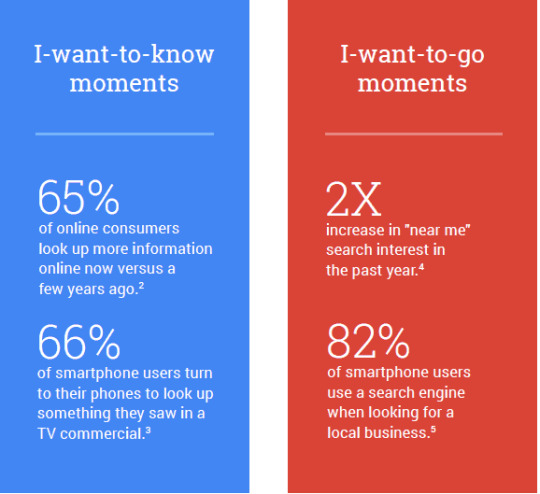

Does it all make sense now? It really is that simple.
So, what am I driving at?
Basically, your brand will appear in the search results if you effectively interpret such moments through SEO.
Let’s see how you can do this…
Tell Compelling Brand Stories
Allow me to take you back to 2016.
Can you guess what closed the year as the world’s highest selling album? Ok, I’ll give you a hint. It was composed around an infidelity theme, taking listeners through various stages a victim goes through. From discovery all the way to forgiveness.
Yes, you’re dead right. Beyonce’s Lemonade album.
Admit it. This was an unusual one, to say the least. No, at least not because of the fact that it was a visual album. We’ve seen that concept quite a couple of times now.
Its success had everything to do with the story surrounding it. It was emotional. And most importantly, admittedly compelling to the pop culture audience.
It turns out that the plot started unrolling as early as 2014. A rather controversial video was leaked, showing an infuriated Solange (Beyonce’s sister) fighting the singer’s husband, Jay–Z.
The web was excited. And the video went viral. Consequently triggering rumors that perhaps the husband might have been unfaithful to the singer.
And for two years, the rumors were just that. Nothing more than hearsay gossip, which only increased overall curiosity.
Then boom! The album dropped and it let the cat out of the bag. Everything was confirmed and the singer even revealed further details.
The result? Let’s just say that the storyline was worth over $50 million. Since the album ultimately sold more than 2.5 million copies.
Now, this is a perfect example of how compelling brand stories can build a substantial online following. You just have to find a way to connect with your target audience. Through stories that actually matter to them.
This is precisely where content marketing comes in.
Take prospects within the want-to-do micro-moments for instance. They could very much use educative content.
Their want-to-do counterparts, on the other hand, would be more interested in entertaining pieces.
But one story is never enough. You have to do regular engagement stories spreading across multiple moments. 47% of consumers usually view about 3-5 content pieces before proceeding to buy.
Thanks to such consumer behavior, marketers prioritizing on blogs usually attract 13 times more leads. Certainly one of the most effective ways to get noticed by Google and create brand awareness.
And you know what? Any content doesn’t cut it. It has to provide actual value. Coming to think of this, it makes sense why the average length of Google’s top content pieces is 1,140-1285 words.
That said, you have to admit that written words alone might be bland. And Google knows this. That’s why its algorithm goes further to factor in other content types.
I’m talking about things like videos, infographics and images. Precisely what your audience would be interested in.
So far, we’ve seen blog articles with images attract about 94% more views. You could say we all like our articles with some dose of graphics and pomp.
Optimize Social Media Engagement
Social media is, by far, the most expansive online platform today. No doubt about that. It hosts more than 2.5 billion users and still growing.
Then, going by the fact that users are increasingly registering multiple accounts, the overall number of accounts might soon surpass the total human population. Fascinating, huh?
What does this mean?
Well, of course, companies like Facebook will continue keeping their accountants busy. And so will your business, if you tactfully capitalize on this opportunity.
You’ve probably seen how enterprises have been trying to do this.
From 2008, up until sometime in 2015, they were particularly fond of Facebook. They overwhelmingly registered pages and bombarded users with brand messages.
And to be honest, some of them actually got impressive results. That’s why 92% of marketers, by 2014, were already convinced that social media was extremely important for their businesses.
Until Facebook finally decided enough is enough. According to them, users’ timelines were predominantly filled with irrelevant content from multiple brand pages.
So, in response, they scaled down organic page posts. Then users started connecting more with their actual friends than brand pages.
It also meant more income for Facebook. I actually believe that this might have their principal objective.

Source: ConvinceandConconvert
But, let’s save that debate for later. And focus on the bottom line instead. That social media engagement for brands has changed drastically.
Even Youtube and Twitter joined the bandwagon with algorithm changes that favor user connection over brand engagement.
Consequently, social media organic reach for brands has dropped sharply in recent years. The Financial Times, for instance, reported a 42% decline in organic Facebook reach.
Marketing Land also did a follow-up assessment and established a 52% drop.
Quite devastating, right?
Wrong! The most strategic brand marketers actually love this. Because it gets rid of the spam and bots. Then leaves the game to the real gurus who understand what brand awareness is all about.
So, no. You don’t have to pay even a dime to promote your brand on social media.
The secret is pretty straightforward. Simply dance to their tune.
Instead of fighting their user–optimized engagement algorithms, find ways to leverage it to boost your brand.
Take Facebook, for example. Content shared by a user will ultimately be posted to all their friends’ timelines. And the more the engagement frequency on that post, the wider Facebook’s algorithm will spread it.
Now, which specific content type can’t social media users get enough of?
Yes, of course. Videos.
55% of internet users watch online videos on a regular basis. And Facebook is responsible for about 8 billion video views every day.
Catch my drift? Your page post might only reach a fraction of your followers. But, if it’s a compelling video, they’ll watch it and subsequently share with to their friends. Who’ll then watch it and the cycle continues.
Even Facebook agrees that videos engage way more prospects than other content types. Including photos, regular status updates, and links.

Source: Facebook
Reach Out To Influencers
One thing that large businesses might have an edge over you in is celebrity advertising.
And from what we’ve seen in the past, some of these celebs have cult-like followings. They might even be more popular than Santa. Or the Eiffel Tower.
It’s understandable that they possibly seem like a buffet rich in prospects at first. That’s why they charge money that would only come by if you robbed a bank.
But, take a minute and think again.
Going by recent trends in band marketing, most people can actually see through their paid promotions. As a result, prospects end up ignoring everything altogether.
Mainstream celebrities have been overtaken by digital influencers, who now sit at the top of the brand marketing food chain. And no, not by a foot or two. But by several miles.
Consider this. 30% of consumers are more likely to purchase items suggested by influencers, as opposed to celebrities.
All because of one simple reason. Individuals essentially feel more connected to non-celebrities.
Collective Bias even conducted a study on this by interviewing more than 14,000 consumers based in the US. It subsequently established that 70% of the millennials consider peer recommendations in the whole buying process.
Now, this is literally driving all marketers insane. Everyone now wants in on the action. Hence the following remarks on the developing role of influencer marketing:

Source: Statista
Pretty exciting, right?
But, hold your horses for now. While this type of marketing is proving to be increasingly effective, not all influencers would be ideal for your brand.
Secondly, remember we are only reviewing free tactics? So, no, you will not be paying anyone.
Where does that leave you?
Simple. Just search widely and reach out to your friends in high places. But focus only on selected influential websites that are relevant to your business field. That’s how you generate organic interest in your brand.
A thoughtful approach would be running a parallel complementary campaign along with your influential partners. Promoting their brand as they push for yours is a good way to keep your marketing invoice at zero.
Distribute Valuable Guest Content
Remember those few occasions your school hosted guest speakers?
What did you think of them?
Well, I admit that I didn’t actually recognize more than half of my share of speakers. But, I always thought of them as big shots for being invited to such platforms.
And, of course, I’ve always remembered the talks that were exceptionally captivating.
Undeniably, that’s pretty much how guest posting goes.
Just one small exception. Don’t hold your breath for an invitation. Or you might be waiting around till a second big bang.
Take your time to scour the web for the most outstanding platforms that are relevant to your field. Then reach out to their editors with your guest content proposal, and see how it goes.
At the very worst, some might not bother getting back to you, which isn’t that big a deal. But, you’re bound to get a couple of positive replies, especially if your content is exquisitely valuable.
Now, this is where it usually gets complicated for most people.
Typical run-of-the-mill content doesn’t cut it. Because you’re not just seeking SEO links. You need the audience to respect you as a thought-leader, and subsequently recognize your brand.
This is only achievable through valuable, engaging guest content.
So, surprise the audience with something they never expected. A deep composition that’s very helpful that it compels them to excitedly share it with their friends.
And guess what? 94% of individuals who share content actually do so to help others.
Valuable content, therefore, potentially expands its audience reach quite substantially with each new viewer.
That’s how BufferApp was able to raise awareness and acquire about 100,000 users in just 9 months.
Let’s just say that Leo Widrich, its co-founder is one remarkably persistent guy. Within that time, he had written and distributed 150 solid blog posts.
Admittedly, this entire process wasn’t easy at all, not by a long shot. The initial pieces were particularly poor since they drove very little traffic.
But things gradually improved as he widened his channels and optimized traffic analytics.
Ultimately, 100,000 new users were quite a rewarding catch, to say the least. And that formed their baseline users, from where they were able to escalate their brand marketing to boost the users tenfold.

Source: Buffer
Conclusion
You thought selling should be your principal focus? Well, get this. 70% of brand managers say that rallying an audience around your brand is far more important than converting sales.
The whole point of a branding strategy is establishing trust. Then using that as a stepping stone to build a following. And that’s when you’ll be able to seamlessly convert them into sales.
Of course, you could spend some bucks on it to market your brand. But one thing’s for sure. You could as well achieve extensive brand awareness without spending a dime.
If anything, 59% of consumers don’t trust sponsored campaigns.
Consider using compelling brand stories to build a substantial online following. You just have to find a way to connect with your target audience. Through stories that actually matter to them.
And you have to do regular engagement stories spreading across multiple moments. 47% of consumers usually view about 3-5 content pieces before proceeding to buy.
Instead of fighting social media user–optimized engagement algorithms, find ways to leverage it to boost your brand.
Then search widely and reach out to your friends in high places. But focus only on selected influential websites that are relevant to your business field. That’s how you generate organic interest in your brand.
Finally, take your time to scour the web for the most outstanding platforms that are relevant to your field. Then reach out to their editors with your guest content proposal, and see how it goes.
Action Steps To Remember:
Go through the article
Implement each tactic to your business as you see fit
Measure the results on a weekly basis
Adjust your strategy accordingly
Do you know of any tips we missed? Let everyone know in the comments below!
The post How To Create Brand Awareness For Free appeared first on Joseph Paul Digital Agency.
0 notes
Text
A Beginners Guide To Content Marketing For Real Estate
A Beginners Guide To Content Marketing For Real Estate
Are you having trouble getting new leads from your blog efforts?
Are you not getting any leads from online because you’re part of the 5% who isn’t on the web?
Don’t worry about it because you’re alone.
Buying a home is one of the biggest purchases someone will make in their lifetime, so naturally, they want to work with someone they feel they can trust.
You need to find a way to build trust with a stranger and convey to them that you understand their needs.
It sounds like a daunting task but if you have the right strategy and mindset you’re going to be the model for others to try to replicate.
Know your customer
It’s only right we start with the foundation of your livelihood of what you do and consider the people.
Notice how I said people and not keywords. You never take a phone call from a keyword who’s wanting to buy a property.
It’s important that you really drill down on who your customer is personally.
Creating a customer persona can increase your conversion rate because you’re not targeting a “market” or a keyword.
A customer persona is where you create a customer profile of a person like you’re filling out their Facebook profile.

Companies like Buffer are advocates of using personas as their north star to creating their content.
It’s important not to guess when doing this and base your persona off of facts you find through research.
To start your research look for forums that relate to the real estate market and home buying experience.
It’s easy to find these forums, go to Google and type in the search your product or service and add “forum” (with the speech marks) then pick the top 3-5 forums.
Look for at least three pain points, three things they like and finally three reasons why they won’t buy.
Also check reddit because there the users have already done the hard work for you by voting on the topic, saving you time on deciding if it’s an important topic or not.
You also want to use Google’s auto-suggest function capture phrases that your potential visitors are searching.

For a more in-depth guide, Opti Monster provides a great process with templates.
Find creative ways to guest post for influencers
You’ve nailed down the person(s) you’re writing for but now you need to figure out where to post your content.
Of course, the number one spot you should be hosting your content is your website because that’s where your call to actions is to get visitors to become leads.
If you want to build trust with your real life personas then a great way is to guest post on an influencers site.
70% of millennials prefer product endorsements from non-celebrity bloggers.
According to NerdWallet, it is a priority to purchase a home by 82% of millennials.
It’s a good idea to get in front of the people who are prioritizing purchasing a home in the near future.
If you’re thinking, well no one in the real estate industry is accepting guest posts, don’t worry about it.
Follow Neil Patel’s lead by bridging the real estate market to other niches that can find your industry interesting.
He provides examples that relate to marketing but you can bridge to any type of niche, here are some ideas:
How a realtor coached their client in style to sell their home for 10% more than asking price.
How a realtor negotiated a home price below asking by utilizing social media.
These may be extreme examples but they get you into different niches that help you get in front of your persona.
An easy way to have guest posting opportunities to come to you is to sign up for BloggerLinkUp, where you’ll get an email every Monday, Wednesday, and Friday with opportunities to guest post.
If you’re hell-bent on guest blogging on a particular website, take the domain and place it into aherfs and see what their most popular content is.
Determine if you can bridge that topic with real estate and reach out to the site owner and say “Hey – I have a great blog post about XYZ that fits right in your niche and your readers would love!”
This shows you did your legwork and is a good signal you’re going to have quality content for them.
Create long-form content
I know I sound like a broken record but long-form content is always one of the best ways to create awareness of your brand and build trust with new visitors to your site.
Now that you’re an expert on your user’s gripes, likes, and reasons they won’t contact you, you can proactively create content around that to address or amplify those points.
When creating long-form content, it’s best to create content that is educational and informational.
We have been bombarded by advertisements and sales pitches so to have a piece that can be educational is a nice breath of fresh air that will build trust with visitors who could eventually become clients or refer you to a friend.
Long form content improves your ability to show up for long tail searches which increased traffic by 20% for the people WPBeginner.
Long tail keywords are searches that include 4+ words in the search.
Long tail keywords typically have lower search volumes but they make up for 70% of search traffic on the internet and are much easier to compete in.

Imagine trying to rank for the keyword “homes in Troy” and how hard it would be to compete in that search.
Now imagine if you were targeting a long tail phrase like “best neighborhoods in troy for parents,” that would have much less competition and would be much easier to rank in the top ten searches.
Creating long-form content generates more long tail keyword opportunities and ultimately more traffic.
Know your content type options
Not everyone enjoys getting their information through reading. Images are like and shared more than 3x than any other media.

The best part of using different mediums to communicate your content through a different medium is you can take a topic you’ve already created and repurpose it.
We are going to stick to three types of media that generate great opportunity to be shared and earn backlinks.
Infographics
Infographics are graphics that combine statistics with imagery to make the complex or mundane topic more interesting and easily digested.
It’s not surprising the popularity of infographics because 65% of people are visual learners.
Not only are the majority of people visual learners, visuals are processed 60,000 times faster versus text.
There are few ways to go about deciding when to use infographics.
The first way is to go to your content and pick your most popular topics and repurpose them as infographics.
The reason you’re doing this is that it already shows that the content is warmly accepted by your searchers and popular among others enough to share it.
Take it a step further by turning it into an infographic to make it more shareable.
The second way to find infographic ideas is to go to your competition and find which of their posts are doing really well and has the most backlinks via ahrefs.
Create a great infographic that captures all the information from their post and make it more digestible.
Once you’ve done that use ahrefs again to find who has linked to the post and use BuzzSumo to find everyone who shared their content.
Now reach out to those people via email with a link to your infographic saying “I noticed you shared article XYZ. I have an infographic that is updated and digestible. I think your followers would love it.”
Now you don’t have to become a designer to make an infographic. You can hire someone from UpWork or if you’re on a budget, use Fiverr to get it at a fraction of the cost.
Last step you want to upload the infographic to your site and generate embed code for your website so you can make it easier for people to share and copy your infographic.
Now you’re ready to reap the 50 times the engagement rewards that infographics provide.
Videos
With internet speeds and broadband speeds improving over time, videos have become more popular than ever.
A survey done shows that 78% of people watch videos at least once a week.
54% of those watching branded videos click through to the brand’s website too.
Here’s how you can leverage videos when you’re in the real estate industry.
The first way is the easiest because it’s easily outsourced.
You find content for these videos with the same steps you used to find content for your infographics.
vimeo
This video does a great job of taking a complex topic and simplifying it for viewers to understand.
The second way to use video is to use a live video that has you in it to build trust.
One way to use a live action is to have a video that tells your story and why you’re in the real estate industry.
youtube
The key here is to be authentic and relatable so that the viewer feels a connection with you.
If you’re camera shy and you have clients who are not, a great way to incorporate a live-action video is to have your past clients give testimonials of their experience with you.
Be sure to make sure the video comes off authentic and to use these tips to create a great testimonial video that doesn’t seem staged or risk hurting the trust.
youtube
A recent study showed that video testimonials had the highest effective rating for content marketing by 89%.
Lastly, creating virtual tours of the homes you’re showing boosts great results and sets expectations for the viewer to motivate them to contact you about the listing.
For animated videos, you can go to UpWork or Fiverr again because the animator can independent of your location.
To do live professional videos you need someone local with equipment. The cheapest high-quality way to get this done is to reach out to local videography schools and ask if you can hire a student to do the project for you.
This live video cost me less than $500 but is part of the reason why I had so many social shares.
youtube
Quizzes
Quizzes are a form of interactive content and studies showed a higher level of deep learning when utilizing interactive content.
Chances are you’ve had an awkward aunt who is part of the average 1,900 social shares that took a quiz to determine which shoe she was.

The reason why this works so well is that it feeds the ego and it has a personalized feeling to it.
Don’t believe the power of these quizzes? BuzzFeed has perfected the quiz and continue to use it.
Their quiz Which State You Should Actually Live In got 3.7 million shares.

How can you create a quiz that is “what city you should move to” or “what kind of a house are you?”
This will get traffic to your site and social shares from people who are thinking about moving or at least interested in homes.
If you’re using WordPress for your website then you’re in luck! Here’s a list of 20+ quiz plugins to help you create a quiz for your website.
Conclusion
Real estate doesn’t have to be a boring topic and you don’t have to always be selling all the time to be successful in real estate on the web.
Make sure you start with the foundation of creating detailed personas of your customers that include details like age, sex, income, number children, and their children’s age.
You then want to start creating long-form content around the gripes, likes, and reasons for contacting you so they have content that is valuable to them.
You also want to sensor overload them with infographics, videos, and quizzes which encourages social sharing.
If you do these correctly, you’re going to be the realtor or brokerage that everyone else in their trails.
If you’ve tried different approaches then I’ve listed, tell me in the comments or ask me any questions, I’m happy to help.
The post A Beginners Guide To Content Marketing For Real Estate appeared first on Joseph Paul Digital Agency.
0 notes
Text
Infographic: How Online Reviews Impact Your SEO & Digital Business
You’re running your business as business as usual but then you start to realize that it’s easier than ever for customers to share their past experience with the world.
You’re using social media as a marketing medium (right?) but so are your past and future customers. How does this impact your business and should you be worrying about it?
In this infographic below we are going to show you exactly how these reviews are impacting your business and how to deal with them.
Did we miss anything? Share what your experience with online reviews and how you handled them.

Share this Image On Your Site
Please include attribution to https://jpda.co with this graphic.

The post Infographic: How Online Reviews Impact Your SEO & Digital Business appeared first on Joseph Paul Digital Agency.
0 notes